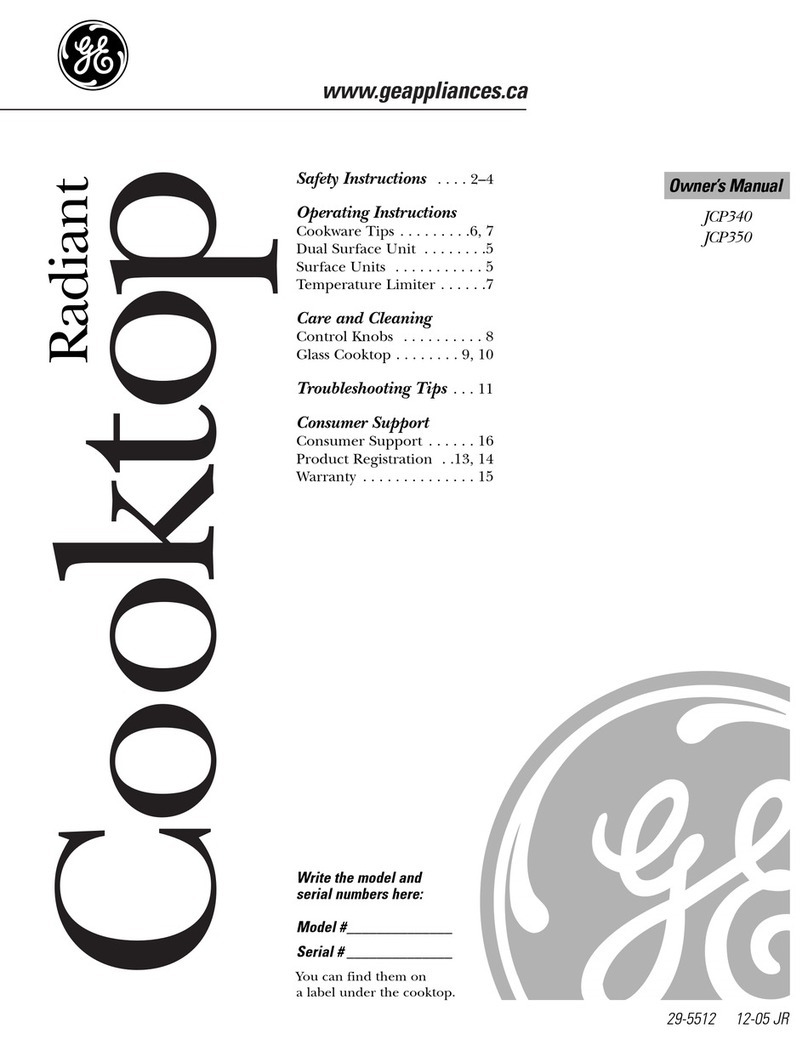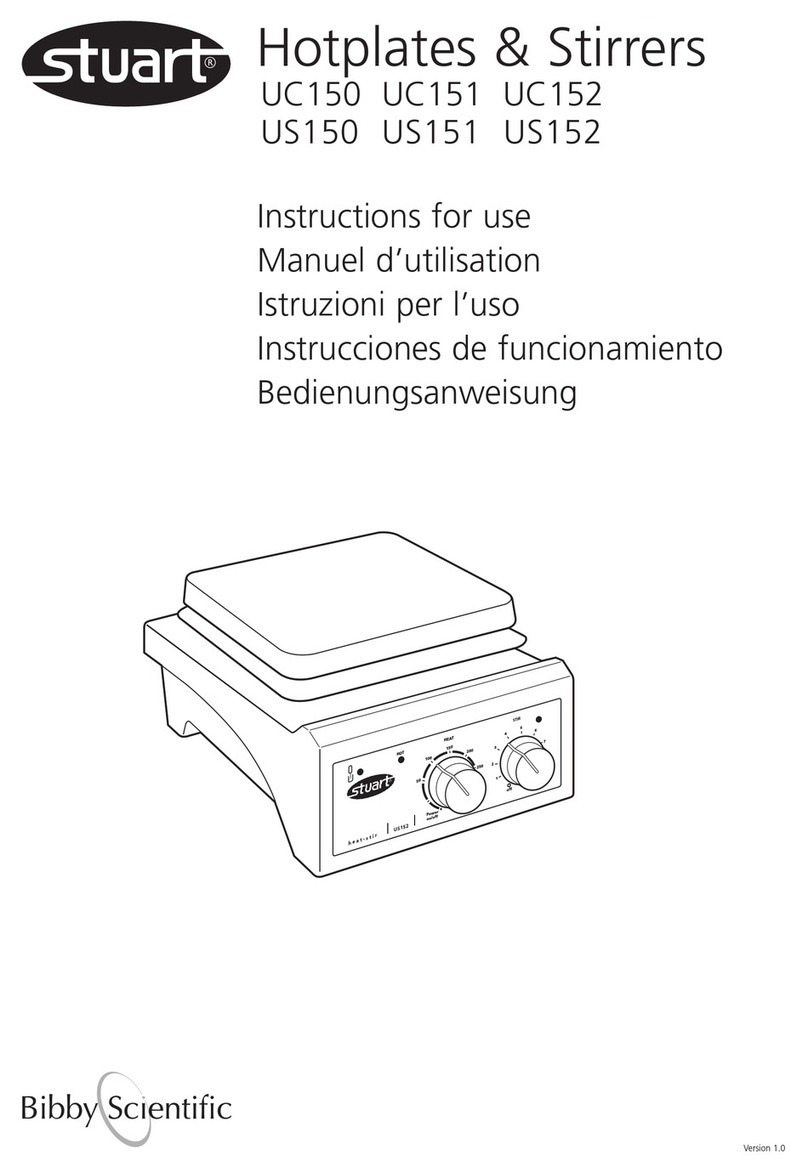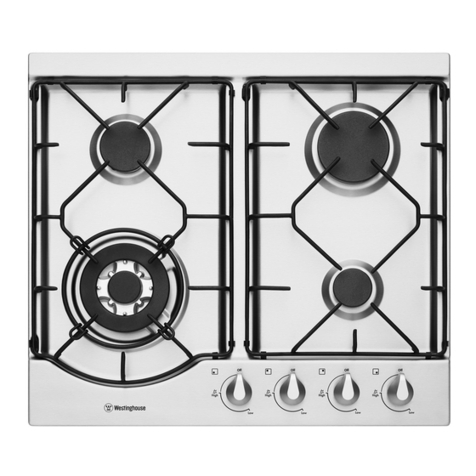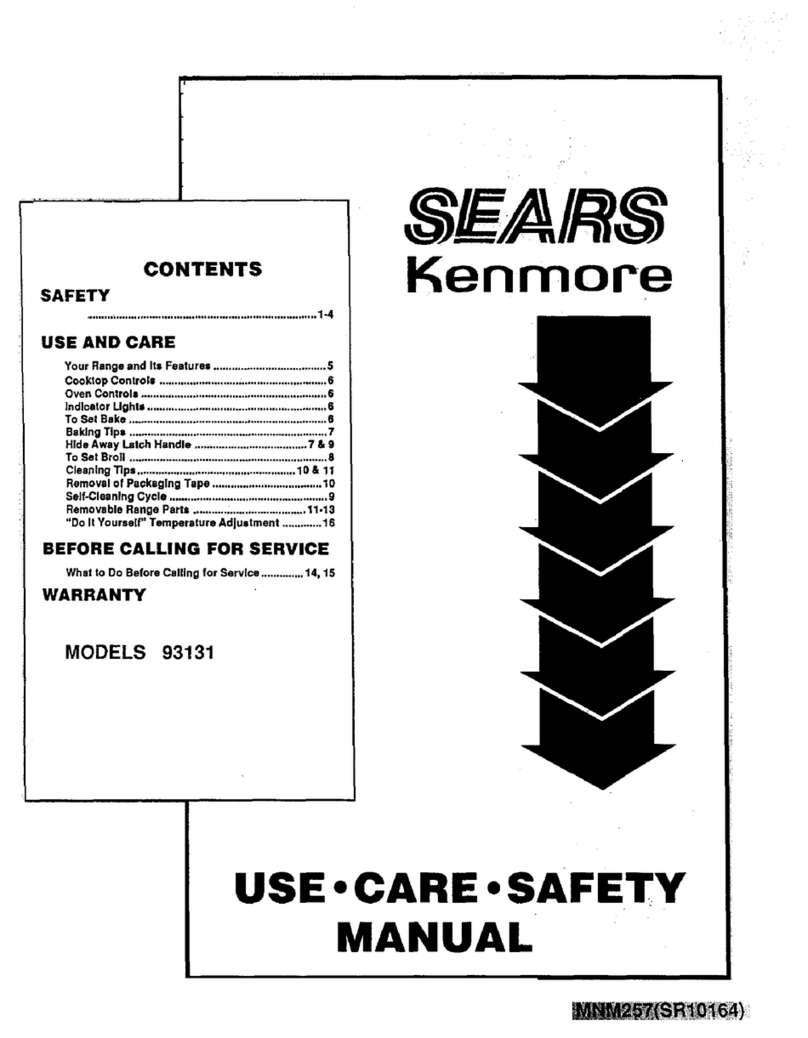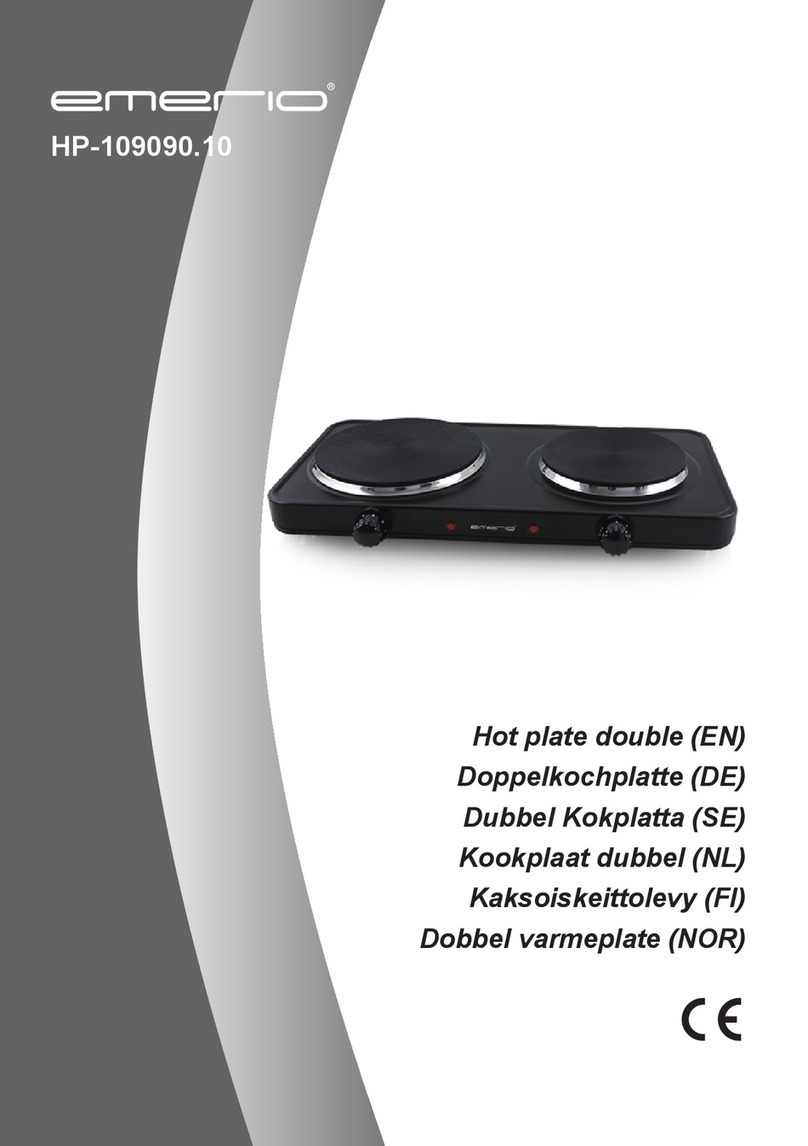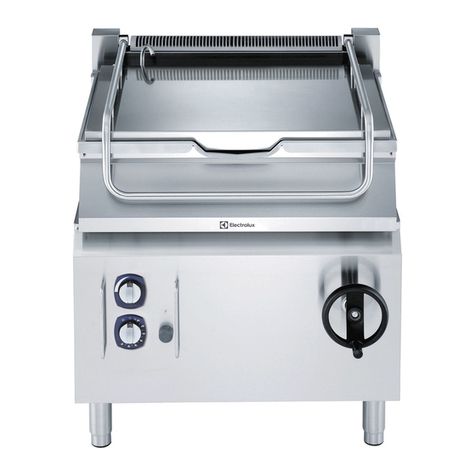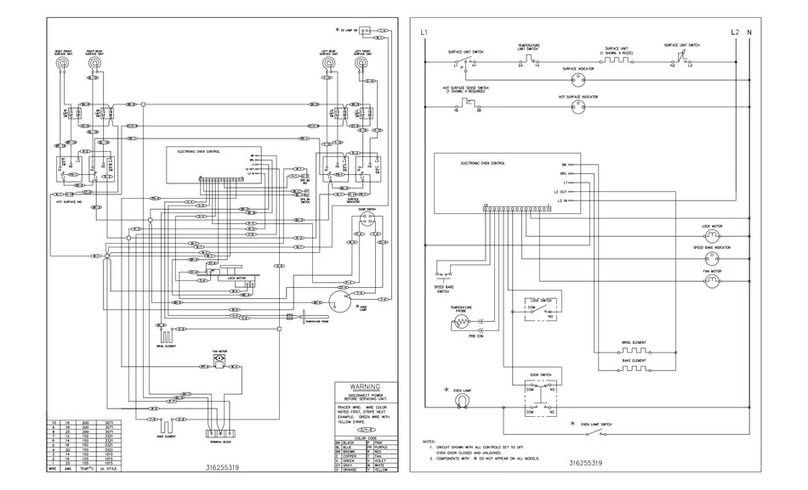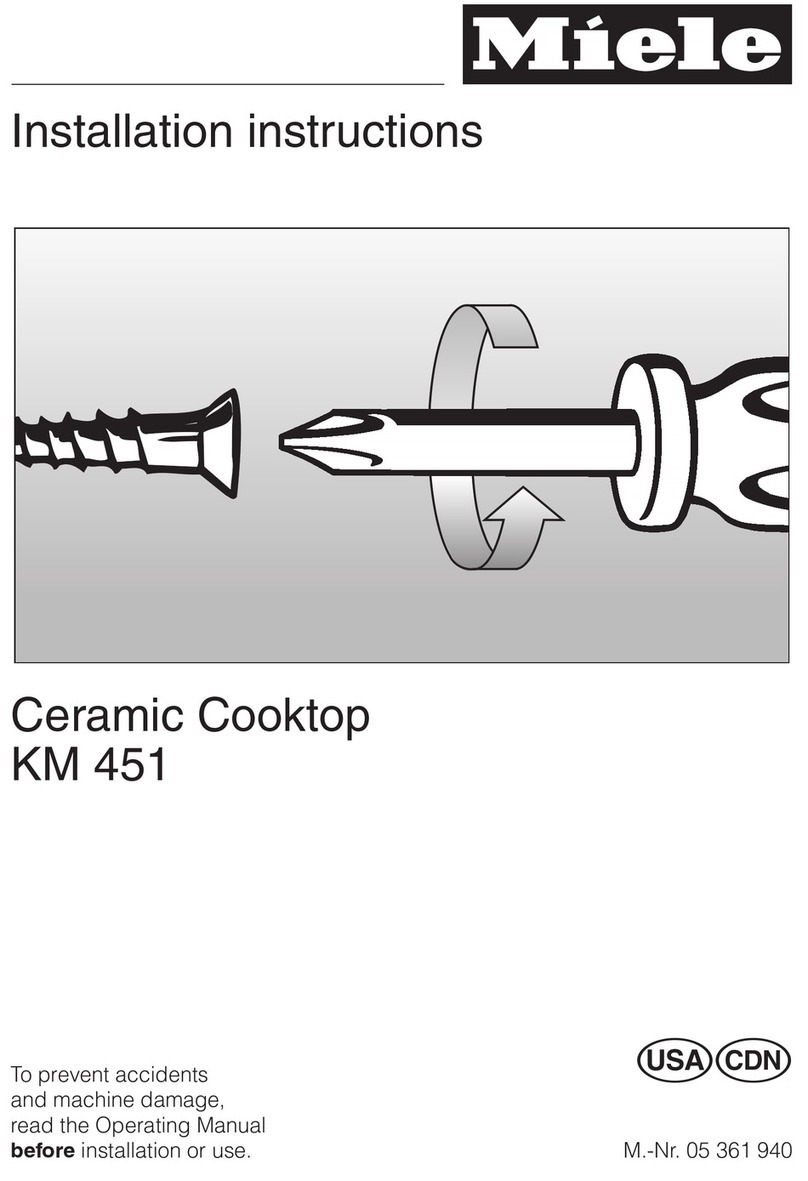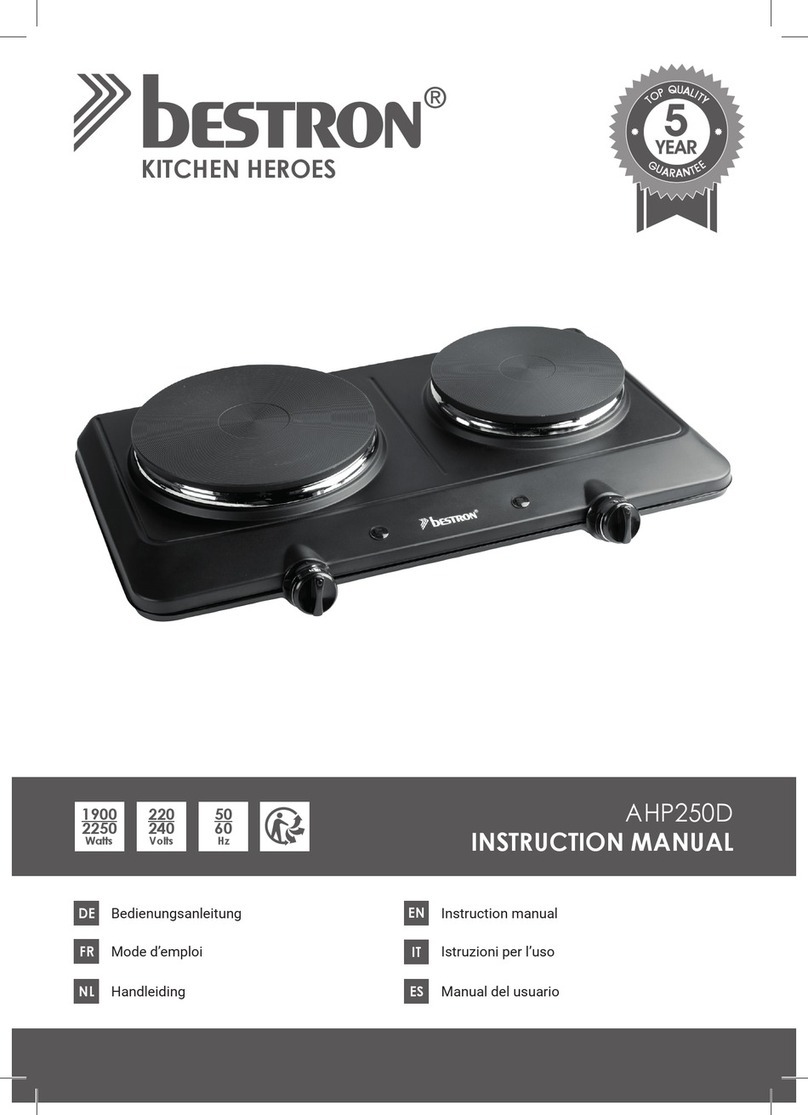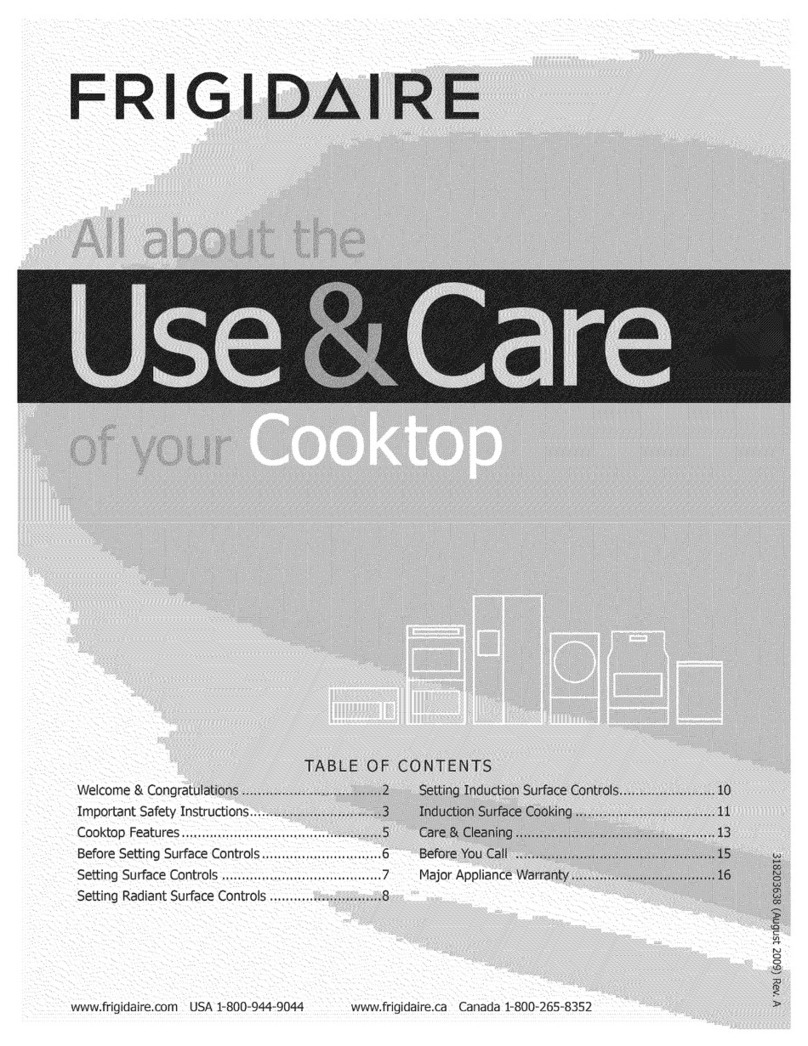Baron 700 Series Guide

Data Emissione 17/09/2004 Revisione 0.0
1
AVVERTENZE D’INSTALLAZIONE USO E MANUTENZIONE
AUFSTELLUNG, GEBRAUCHS- UND INSTANDHALTUNGS ANWEISUNGEN.
INSTRUCTION FOR INSTALLATION, ADJUSTEMENT, USE AND MAINTENANCE
NOTICES D’INSTALLATION, DE REGLAGE, D'EMPLOI ET D'ENTRETIEN
AANWIJZINGEN VOOR DE INSTALLATIE, HET GEBRUIK EN HET ONDERHOUD.
INSTALLATION - VEDLIGEHOLDELSES - OG BRUGSVEJLEDNING
Cod. 827730113
IT Piani di cottura in vetroceramica Pag. 2
DE Elektroherde mit Glaskeramikkochfläche Pag. 8
GB Cook tops of pyroceram Pag. 14
FR Plans de cuisson en vitroceramique Pag. 19
NL Glasceramiekekookplaten Pag. 25
DK Kogeplader af glaskeramik Pag. 31
SERIE 700 / 900

Data Emissione 17/09/2004 Revisione 0.0
2
INDICE
1 - ISTRUZIONI PER L'INSTALLAZIONE pag. 3
1.1 Identificazione modelli pag. 3
1.2 Dati tecnici pag. 3
2- AVVERTENZE GENERALI pag. 3
2.1 Installazione pag. 3
2.2 Posizionamento pag. 3
2.3 Montaggio pag. 3
2.4 Montaggio top su base pag. 3
2.5 Montaggio apparecchiature in linea pag. 3
2.6 Montaggio apparecchiature a ponte pag. 3
2.7 Collegamenti elettrici pag. 3
2.8 Collegamenti di terra ed equipotenziali pag. 3
3 - MESSA IN FUNZIONE pag. 3
3.1 Verifica di funzionamento pag. 3
4 - ANALISI DI ALCUNI MALFUNZIONAMENTI pag. 4
4.1 Piano di cottura pag. 4
4.2 Forno pag. 4
5 - SOSTITUZIONE DI PARTI SOGGETTE A RICAMBIO pag. 4
5.1 Interruttore, regolatore di energia piano di cottura pag. 4
5.2 Piastre radianti pag. 4
5.3 Lampade segnalazione piano caldo pag. 4
5.4 Lampade segnalazione piano cottura pag. 4
5.5 Termostato sicurezza forno pag. 4
5.6 Regolatore energia, lampade segnalazione forno pag. 4
5.7 Resistenze forno pag. 4
5.8 Interruttore termostato di lavoro del forno elettrico pag. 4
6 - ISTRUZIONI PER L'USO E LA MANUTENZIONE pag. 5
6.1 Avvertenze pag. 5
6.2 Utilizzazione piano di cottura pag. 5
6.3 Utilizzazione forno pag. 5
6.4 Disinserimento in caso di guasto pag. 6
7 - PULIZIA E MANUTENZIONE pag. 6
8 - ELENCO PARTI SOGGETTE A RICAMBIO pag. 7
APPENDICE pag. 36

Data Emissione 17/09/2004 Revisione 0.0
3
1 - ISTRUZIONI PER L'INSTALLAZIONE
1.1 Identificazione Modelli
Serie 700 Serie 900
Piano di cottura a 2 elementi "TOP" 803151725 803161725
Piano di cottura a 4 elementi "TOP" 803151745 803161745
Piano di cottura a 2 elementi su "VANO" 803111725 803121725
Piano di cottura a 4 elementi su "VANO" 803111745 803121745
Piano di cottura 4 elementi su "FORNO" 803131745 803141745
1.2 Dati tecnici
I dati tecnici delle apparecchiature sono riportati nella Tabella T1
allegata.
2- AVVERTENZE GENERALI
Leggere attentamente le avvertenze contenute nel presente
libretto in quanto forniscono importanti indicazioni riguardanti la
sicurezza di installazione, d'uso e di manutenzione. Conservare
con cura questo libretto per ogni ulteriore consultazione dei vari
operatori.
L'installazione deve essere effettuata secondo le istruzioni del
costruttore ed in conformità alle norme di sicurezza in vigore da
personale professionalmente qualificato.
Il mancato rispetto di tali obblighi causa la decadenza di
ogni responsabilità da parte del costruttore.
NOTA Le apparecchiature sono conformi alle prescrizioni della
Norma CEI 61-50
2.1 Installazione
Dopo aver tolto l'imballaggio assicurarsi dell'integrità
dell’apparecchiatura. In caso di dubbio non utilizzare la stessa e
rivolgersi a personale professionalmente qualificato.
Gli elementi d’imballaggio non devono essere lasciati alla portata
di bambini in quanto potenzialmente fonti di pericolo.
2.2 Posizionamento
L'apparecchiatura dev’essere sistemata nella posizione definitiva
che occuperà in cucina e preferibilmente sotto una cappa
d’aspirazione, atta a permettere una buona rigenerazione d'aria.
L'apparecchiatura dev’essere installata in locali sufficientemente
aerati.
La distanza dell'apparecchiatura da pareti circostanti dev’essere
almeno di 10 cm, questa distanza può essere ridotta in presenza
di pareti incombustibili o protette da isolante termico.
Le apparecchiature possono essere installate separatamente
oppure composte con altre apparecchiature della nostra gamma.
L'apparecchiatura non è adatta per l'incasso.
2.3 Montaggio
Togliere dai pannelli esterni la pellicola protettiva. Eventuali
residui di collante devono essere rimossi con idoneo solvente.
Livellare l'apparecchio agendo sui piedini regolabili.
L'apparecchiatura di larghezza 40 cm installata singolarmente
dev’essere fissata al pavimento utilizzando le apposite flange,
vedere Fig. 5.
2.4 Montaggio del top su base neutra Fig. 3
Per eseguire il montaggio del "top" con la relativa base neutra
occorre:
- Rimuovere il pannello comandi e lo schienale del top
- Posizionare il top sulla relativa base
- Fissare le due apparecchiature tramite le 4 viti V come indicato
in fig.3
- Rimontare il pannello comandi e lo schienale del top
2.5 Unione in linea delle apparecchiature Fig. 2
Procedere come segue:
- Rimuovere il pannello comandi del top.
- Accostare le apparecchiature e livellarle alla medesima altezza.
- Fissarle con le apposite viti come indicato in Fig. 2.
- Rimontare il pannello comandi.
2.6 Montaggio apparecchiature top a ponte fig. 4
- Fissare le due traverse di sostegno T utilizzando gli appositi fori
previsti sui fianchi delle apparecchiature contigue di sostegno.
- Livellare accuratamente le due apparecchiature di sostegno.
- Posizionare il top sulle traverse e rimuovere, dallo stesso il pannello
comandi e lo schienale.
- Fissare il top alle traverse con le 4 viti V come indicato in fig.3
- Eseguire il fissaggio con le apparecchiature affiancate come indicato
in fig.2.
- Rimontare lo schienale, il pannello comandi.
2.7 Collegamenti elettrici
- Il collegamento alla rete d'alimentazione elettrica dev’essere eseguito
secondo le norme vigenti.
- Prima di collegare l'apparecchiatura accertarsi che i dati di targa
corrispondano a quelli della rete di distribuzione.
- Il cavo d’alimentazione dev’essere di tipo flessibile, con caratteristiche
non inferiori al tipo con isolamento in gomma H05RN-F e dev’essere
protetto con tubo metallico o in plastica rigida.
Il cavo dev’essere connesso alla morsettiera come indicato nello
schema elettrico e poi bloccato con l'apposito pressacavo.
- A monte dell'apparecchiatura e nelle sue immediate vicinanze,
dev’essere installato un interruttore onnipolare di protezione i cui
contatti devono aprirsi ad una distanza di almeno 3 mm.
Quest’interruttore dev’essere installato nell'impianto permanente del
fabbricato e dev’essere di portata adeguata, vedere tabella T1allegata.
Questo interruttore deve garantire la protezione contro contatti diretti
ed indiretti delle parti sotto tensione e delle correnti di guasto verso
terra, secondo le Norme. ( Massima corrente di dispersione ammessa
1 mA/kW).
2.8 Collegamenti di terra ed equipotenziali
La sicurezza elettrica di quest’apparecchiatura è assicurata soltanto
quando la stessa è correttamente collegata ad un efficace impianto di
messa a terra come previsto dalle vigenti norme di sicurezza elettrica.
E' necessario quindi collegare il morsetto di terra, indicato con il
simbolo sulla morsettiera dell'apparecchiatura, all'impianto di
messa a terra generale. L'apparecchiatura deve inoltre essere inclusa
in un sistema equipotenziale, questo collegamento viene effettuato con
la apposita vite contrassegnata con il simbolo
3 - MESSA IN FUNZIONE
3.1 Verifica di funzionamento
- Prima di mettere in funzione l'apparecchio inserire l'interruttore
generale d’alimentazione posto a monte dello stesso.
- Seguire le istruzioni per l'uso previste nello specifico paragrafo.
- Spiegare all'utente il funzionamento dello apparecchio con l'aiuto del
libretto istruzioni.
- Controllare il funzionamento dei sistemi d’areazione del locale.

Data Emissione 17/09/2004 Revisione 0.0
4
- Accertare la corrispondenza dei dati di targa con quelli della
rete di distribuzione elettrica
Avvertenza: durante il funzionamento prestare la massima
attenzione alle zone calde della superficie esterna; in
particolare l'accensione delle lampade spia, H2 - H5 in fig. 1
e 1/A, indica che il piano in vetroceramica è ad una
temperatura superiore ai 70 °C.
4 - ANALISI DI ALCUNI MALFUNZIONAMENTI.
Durante l'uso regolare dell'apparecchiatura si possono verificare
dei malfunzionamenti:
4.1 Piano di cottura
Le piastre radianti non si riscaldano possibili cause
- mancanza d’alimentazione elettrica,
- regolatore difettoso,
- piastra radiante difettosa,
- mancanza di continuità elettrica dovuta a difetto di cablaggio.
4.2 Forno elettrico
Il riscaldamento della camera di cottura
del forno non si attiva Possibili cause:
- mancanza d’alimentazione elettrica,
- intervento del termostato di sicurezza: (si accende la spia verde
ma non la gialla),
- difetto del termostato di regolazione.
Riscaldamento insufficiente del forno Possibili cause:
-una o più resistenze difettose,
- difetto nel commutatore,
- mancanza di una fase dell’alimentazione elettrica.
Difficoltà di regolazione della temperatura del forno Possibili
cause:
- difetto del termostato di regolazione,
5 - SOSTITUZIONE DI PARTI SOGGETTE A RICAMBIO
Queste operazioni debbono essere eseguite esclusivamente da
personale professionalmente qualificato ed autorizzato
Prima di procedere a riparazioni e/o manutenzioni occorre
togliere l’alimentazione elettrica dell’apparecchiatura
disinserendo l'interruttore generale posto a monte della
stessa.
I componenti sigillati non devono essere manomessi
5.1 Interruttore / regolatore di energia del piano di cottura
- Smontare il pannello comandi del piano di cottura.
- Sfilare le manopole interessate.
- Scollegare il cablaggio elettrico del componente interessato.
- Svitare le viti che fissano il regolatore al pannello comandi
- Sostituire il componente e rimontare agendo in ordine inverso.
5.2 Piastre radianti
- Smontare il pannello comandi del piano di cottura.
- Scollegare il cablaggio elettrico della piastra interessata.
- Svitare la vite di fissaggio della piastra alla traversa di sostegno.
- Svitare i dadi che fissano (tramite molla) la traversa al piano
(per le apparecchiature a 4 piastre può essere sufficiente
svitare i 2 dadi vicini alla piastra da sostituire).
- Sfilare e sostituire la piastra e rimontare agendo in ordine
inverso.
5.3 Lampade di segnalazione piano caldo
- Smontare il pannello comandi del piano di cottura.
- Scollegare il cablaggio relativo dalla morsettiera generale.
- Svitare la vite che fissa il blocchetto al piano di cottura.
- Estrarre il blocchetto portalampade e sostituirlo, procedere al
montaggio agendo nell'ordine inverso.
5.4 Lampade di segnalazione piano cottura
- Smontare il pannello comandi del piano di cottura.
- Scollegare il cablaggio del componente.
- Sostituire il componente e rimontare agendo in ordine inverso.
5.5 Termostato di sicurezza forno
Per il riarmo in caso di intervento occorre procedere alla rimozione
delle cause che hanno generato la sovratemperatura: esame del
funzionamento del termostato di lavoro, resistenze ecc. poi procedere
come segue:
- Smontare il pannello comandi verticale del forno.
- Premere il pulsante rosso del termostato stesso.
- Verificare la richiusura del circuito elettrico.
Per la sostituzione del componente procedere come segue:
- Smontare il pannello comandi verticale del forno.
- Svitare il fissaggio del bulbo posto sul cielo della camera di cottura.
- Estrarre il capillare ed il bulbo dalla camera di cottura sfilandolo dal
fianco esterno della camera stessa.
- Scollegare il cablaggio dal componente.
- Svitare le viti di fissaggio del termostato al supporto.
- Sostituire il componente e rimontare agendo in ordine inverso.
5.6 Commutatore, lampade di segnalazione forno
- Smontare il pannello comandi verticale del forno.
- Scollegare il cablaggio elettrico del componente.
- Sfilare la manopola del commutatore, se interessato alla sostituzione,
e svitarne le viti di fissaggio al pannello stesso.
- Sostituire il componente e rimontare agendo in ordine inverso.
5.7 Resistenze elettriche del forno.
Per la sostituzione della resistenza del cielo anteriore si può agire nel
seguente modo:
- Smontare il pannello comandi verticale del forno.
- Agendo nella zona retrostante il pannello stesso: scollegare le
connessioni elettriche della resistenza interessata.
- Dall'interno camera di cottura svitare le viti di fissaggio della
resistenza stessa.
- Estrarre e sostituire il componente.
Per la sostituzione delle altre resistenze agire come segue:
- Dall'interno della camera di cottura svitare le viti di fissaggio della
resistenza interessata.
- Estrarre, verso l'interno della camera stessa, la resistenza ponendo
attenzione alle connessioni elettriche che sono collegate alla
resistenza.
- Scollegare le connessioni elettriche, sostituire il componente
ristabilire le connessioni elettriche e reinserire la resistenza nella sede
ponendo sempre molta attenzione ai cavi elettrici che devono poter
rientrare nella propria sede.
5.8 Interruttore - termostato del forno
- Smontare il pannello comandi verticale del forno.
- Per la sostituzione del termostato svitare il fissaggio del bulbo posto
sul cielo della camera del forno ed estrarre il capillare ed il bulbo dalla
camera di cottura sfilandolo dal fianco esterno della stessa.
- Scollegare il cablaggio del componente.

Data Emissione 17/09/2004 Revisione 0.0
5
- Estrarre la manopola e svitare le viti che fissano l’assieme
interruttore termostato al pannello comandi.
- L’interruttore termostato sono montati in asse previa
interposizione di un’apposita flangetta di collegamento, agire su
questa per liberare i due componenti.
- Sostituire il componente e rimontare agendo in ordine inverso.
6 - ISTRUZIONI PER L'USO E LA MANUTENZIONE
6.1 Avvertenze
Quest’apparecchiatura dovrà essere destinata per la cottura di
cibi. Ogni altro impiego è da considerarsi improprio.
L'apparecchio è destinato all'uso industriale e dev’essere
utilizzato da personale addestrato.
L'installazione e l'eventuale trasformazione ad altra tensione
d’alimentazione elettrica (se prevista) dev’essere eseguita
esclusivamente da personale professionalmente qualificato ed
autorizzato.
In caso di guasto disinserire l'interruttore generale
d’alimentazione elettrica posto a monte dell'apparecchiatura.
Per la riparazione rivolgersi ai Centri di Assistenza autorizzati ed
esigere parti di ricambio originali.
Il mancato rispetto di quanto sopra indicato può
compromettere la sicurezza dell'apparecchiatura per cui il
costruttore declina ogni responsabilità.
6.1.1 Uso
Non utilizzare il piano in vetroceramica per l'appoggio o lo
stoccaggio di recipienti. Evitare di lasciare sulla base ceramica
ogni tipo di contenitore, in particolare plastica e alluminio che, in
contatto con il calore, potrebbero fondere. Ad ogni utilizzo
controllare che il fondo delle stoviglie e la zona di cottura siano
puliti ed asciutti. Lo sfregamento del pentolame sulla piastra
ceramica può con il tempo danneggiare la superficie. Non
utilizzare il piano in ceramica per la pulizia della verdura o simili.
Utilizzare per quanto possibile pentolame di dimensioni superiori
alla zona di cottura per evitare travasi accidentali sulla superficie
ceramica. Le soluzioni zuccherine sono particolarmente
dannose.
Prima d’utilizzare l'apparecchio pulire accuratamente tutte le
superfici destinate ad entrare in contatto con il cibo.
6.2 Utilizzazione del piano di cottura Fig. 1 - Fig.1/A
Il piano di cottura è composto, a seconda dei modelli, da 2 - 4
piastre radianti. Ogni piastra è comandata da un regolatore
d’alimentazione a diverse posizioni d’inserzione.
L'inserzione del riscaldamento di qualsiasi piastra può avvenire
agendo sulla rispettiva manopola di comando M e viene
evidenziato dall’accensione della lampada di segnalazione H1 -
fig.1 - 1/A
Piastre radianti ad uno stadio di potenza: da 1,2 e 1,8 kW fig.
1 - fig. 1/A
La manopola di comando agisce nel seguente modo:
0 Piastre disinserite
Minima alimentazione piastre
1 circa 10 % d’energia.
Alimentazione intermedia delle
2-8 piastre : dal 20 al 60% d’energia.
9Massima alimentazione piastre
Piastre radianti a 2 stadi di potenza: 2,4 e 3,4 kW
Le manopole dalla pos. 1 alla pos. 9 regolano esclusivamente la
inserzione del ramo centrale della piastra, nel seguente modo:
0Piastre disinserite
1 Minima alimentazione del ramo centrale
della piastra circa 10 % d’energia
2-8 Alimentazione intermedia del ramo centrale
della piastra :dal 20 al 60% d’energia
9 Massima alimentazione del ramo centrale
della piastra
L'inserzione del ramo riscaldante esterno delle piastre a 2 stadi si
ottiene ruotando, in senso orario, la manopola oltre la pos. 9 fino
all'arresto (vincendo l'azione di una molla antagonista)
Al rilascio la manopola ritorna in pos. 9.
Per disinserire il ramo riscaldante esterno della piastra occorre
ruotare, in senso antiorario la manopola fino alla pos. 0
Disinserimento ramo esterno
6.3 Utilizzazione del forno elettrico Fig. 1/B
Dispositivi di sicurezza
Il forno è dotato di un termostato di sicurezza tripolare a riarmo
manuale. In caso di sovratemperature nella camera di cottura questo
componente interviene e disattiva l'alimentazione delle resistenze del
forno. La lampada di segnalazione gialla si spegne mentre quella
verde resta accesa. In questo caso occorre disinserire
l'apparecchiatura portando le manopole MT e ME in pos.0, togliere
l'alimentazione elettrica disinserendo l'interruttore generale posto a
Inserzione ramo esterno

Data Emissione 17/09/2004 Revisione 0.0
6
monte dell'apparecchiatura e richiedere l'intervento di un tecnico
specializzato.
Il forno è dotato di 2 manopole di comando e di 2 lampade di
segnalazione: Fig.1/B
- Manopola dell'interruttore generale e termostato MT per
regolare la temperatura di cottura.
- Manopola del regolatore di energia ME per regolare l'adduzione
di energia alle resistenze del cielo della camera di cottura.
- Lampada di segnalazione verde di "corrente inserita"
- Lampada di segnalazione gialla di “riscaldamento inserito”.
La manopola termostato del forno MT porta le seguenti
indicazioni:
0 Alimentazione disinserita
50 Temperatura minima
100 - 200 Temperature intermedie
300 Temperatura massima
La manopola del commutatore ME del forno porta le seguenti
indicazioni:
0Resistenze disinserite
1 Resistenze cielo.
2 Resistenze suola
3Resistenze cielo + suola
Inserzione del riscaldamento del forno elettrico:
1° PRERISCALDAMENTO
- Ruotare la manopola del commutatore ME Fig. 1/B in pos. 3,
ruotare poi la manopola MT nella posizione riferita alla
temperatura
desiderata, s’accendono le lampade di segnalazione verde e
gialla. Si inseriscono così le resistenze cielo e suola con la
massima potenza fino al raggiungimento della temperatura
scelta, segnalato dallo spegnimento della lampada gialla.
2° COTTURA A TEMPERATURE VARIE
- Ruotare la manopola del commutatore ME nella posizione
ritenuta più adatta, in pos. 1 – 2 o 3.
- Ruotare la manopola del termostato portandola nella posizione
corrispondente alla temperatura desiderata, si accendono le
lampade spia verde (corrente inserita) e gialla (resistenze
alimentate). Al raggiungimento della temperatura scelta si
spegnerà la lampada gialla.
- Si raccomanda di non lasciare la porta aperta durante
l'utilizzo.
DISINSERZIONE DEL RISCALDAMENTO DEL FORNO
- Per disinserire l'alimentazione del forno occorre ruotare la
manopola del termostato MT e portarla in pos. 0, si spengono le
lampade di segnalazione verde e gialla.
- Portare anche la manopola ME in pos. 0
6.4 Disinserimento in caso di guasto.
- In caso di guasto disattivare l'apparecchiatura portando tutte le
manopole M- MT - ME Fig. 1-1A-1B in posizione 0
- Disinserire l'interruttore generale d’alimentazione elettrica posto
a monte dell'apparecchiatura.
- Rivolgersi ad un Centro di Assistenza Tecnica con personale
addestrato ed autorizzato dal costruttore.
7 - PULIZIA E MANUTENZIONE
- Le operazioni di pulizia possono essere eseguite solo dopo aver
disinserito l'interruttore generale dell’alimentazione elettrica posto a
monte dell'apparecchiatura.
Piano vetroceramica.
- Depositi e macchie sulla superficie vetroceramica debbono essere
eliminati rapidamente preferibilmente con piastra ancora tiepida. In
ogni caso prima d’ogni utilizzo di cottura.
- Si raccomanda panno asciutto per depositi leggeri e sottili, l'apposito
raschietto a lametta per depositi più consistenti
- Qualora l'uso dei suddetti mezzi risultasse insufficiente occorre, a
piastra fredda, utilizzare prodotti idonei NON ABRASIVI
- A fine pulizia ungere la superficie vetroceramica con un prodotto
specifico protettivo.
- Sono assolutamente sconsigliati i detersivi in polvere.
Pulizia camera forno
Si consiglia di eseguire ad ogni fine giornata una pulizia del vano forno
usando prodotti adatti allo scopo ed attenendosi ai consigli del
fornitore. la procedura consigliata è la seguente:
- Operazioni da eseguire con camera forno a temperatura inferiore a
70 °C
- Aprire la porta forno e spruzzare un prodotto idoneo sulle superfici da
pulire.
- Chiudere la porta per il tempo necessario alla azione detergente (10-
15 min)
- Aprire la porta con cautela, per la possibile presenza di vapori e
togliere dall'interno la suola ed i reggigriglie per lavarli separatamente.
- Ripulire l'interno della camera e risciacquarla con una spugna
imbevuta d’acqua tiepida.
- Rimontare i componenti tolti ed eventualmente inserire il
riscaldamento per qualche minuto per asciugare la camera.
Superfici metalliche in genere
- Le superfici in acciaio inossidabile devono essere pulite giornalmente
con acqua e detersivi non abrasivi adatti allo scopo, risciacquare
abbondantemente ed asciugare con cura.
Per la pulizia dell'acciaio inossidabile dev’essere assolutamente
evitato l'uso di detersivi contenenti sostanze abrasive, così come è
proibito l'uso di spazzole, paglietta, raschietti d’acciaio comune in
quanto questi depositano sulla superficie inossidabile dei residui ferrosi
che innescano la formazione di "ruggine".
- Non lavare l'apparecchiatura con getti d'acqua
- Non utilizzare oggetti appuntiti che possano incidere e quindi
deteriorare sia le parti in acciaio inossidabile .
- Non usare prodotti corrosivi per la pulizia del pavimento sottostante
l'apparecchiatura.
- In caso di lunga inattività si consiglia di osservare le seguenti
precauzioni:
- Disinserire l'alimentazione elettrica a monte dell'apparecchiatura.
- Pulire accuratamente tutte le superfici.
- Proteggere le superfici in acciaio inossidabile stendendo, con un
panno, un leggero strato d’olio di vaselina.
- Arieggiare periodicamente i locali.
- Sottoporre l'apparecchiatura ad un controllo periodico (almeno una
volta all'anno) da parte di personale professionalmente qualificato.
E' consigliabile la stipula di un contratto di manutenzione.

Data Emissione 17/09/2004 Revisione 0.0
7
8 - ELENCO PARTI SOGGETTE A RICAMBIO
Piano di cottura
- Piastre radianti 3400W - 230V
- Piastre radianti 2400W - 230V
- Piastre radianti 1800W - 230V
- Piastre radianti 1200W - 230V
- Regolatori di energia monocircuito 230V - 13A
- Regolatori di energia a doppio circuito 230V - 13A
- Lampade segnalazione verdi
- Blocchetto a 2 o 4 lampade segnalazione piano caldo.
- Manopole comando regolatori
Forno elettrico
- Interruttore generale quadripolare
- Termostato tripolare di lavoro
- Termostato tripolare di sicurezza
- Commutatore
- Resistenze forno 1500W - 230V
- Lampade segnalazione verdi e gialle
- Manopola termostato
- Manopola commutatore

Data Emissione 17/09/2004 Revisione 0.0
8
INHALTSVERZEICHNIS
1- INSTALLATIONSANWEISUNGEN Seite 9
1.1 Identifizierung der Modelle Seite 9
1.2 Technische Daten Seite 9
2- ALLGEMEINE HINWEISE Seite 9
2.1 Installation Aufstellung Seite 9
2.2 Positionieren Seite 9
2.3 Montage Seite 9
2.4 Montage des Oberteils auf Unterbau Seite 9
2.5 Zur Aneinanderstellung der Geräte Seite 9
2.6 Montage des Oberteils in Brückeninstallation Seite 9
2.7 Elektroanschlüsse Seite 9
2.8 Erdungs-und Potentialausgleichsanschlüsse Seite 9
3- INBETRIEBNAHME Seite 10
3.1 Funktionskontrolle, Betriebskontrolle Seite 10
4- ANALYSEN EINIGER BETRIEBSSTÖRUNGEN Seite 10
4.1Kochfläche Seite 10
4.2 Backofen Seite 10
5- ANLEITUNG ZUM AUSTAUSCH EINZELNER BESTANDTEILE Seite 10
5.1 Schalter, Energieregler der Kochfläche Seite 10
5.2 Strahlungsplatten Seite 10
5.3 Leuchtmelder “heiße Platte” Seite 10
5.4 Kontrolleuchten der Kochfläche Seite 10
5.5 Sicherheitsthermostat Backofens Seite 10
5.6 Energieregler und Backofenskontrolleuchten Seite 10
5.7 Backofensheizkörper Seite 11
5.8 Schalter-Arbeitsthermostat des Elektrobackofens Seite 11
6- BEDIENUNGS- UND WARTUNGSANWEISUNGEN Seite 11
6.1 Hinweise Seite 11
6.2 Gebrauch der Kochfläche Seite 11
6.3 Gebrauch des Backofens Seite 12
6.4 Ausschaltung bei Schaden Seite 12
7- REINIGUNG UND PFLEGE Seite 12
8- LISTE DER VERSCHLEIßTEILE Seite 13
9- ANHANG Seite 36

Data Emissione 17/09/2004 Revisione 0.0
9
1- INSTALLATIONSANWEISUNGEN
1.1 Identifizierung der Modelle
Serie 700 Serie 900
Elektroherd - 2 Kochstellen - Tischgerät 803151725 803161725
Elektroherd - 4 Kochstellen- Tischgerät 803151745 803161745
Elektroherd - 2 Kochstellen auf
Unterschrank
803111725 803121725
Elektroherd - 4 Kochstellen auf
Unterschrank
803111745 803121745
Elektroherd-4 Kochstellen auf Elektro-
Backofen
803131745 803141745
1.2 Technische daten
Für technische Daten über Geräte siehe beiliegende Tabelle T1
2- ALLGEMEINE HINWEISE
Diese Gebrauchsanweisungen aufmerksam durchlesen, da sie
wichtige Angaben über die Installations- , Gebrauchs- und
Wartungssicherheit enthalten.
Diese Gebrauchsanweisungen für jedes andere Nachschlagen
seitens der verschiedenen Bediener sorgfältig aufbewahren.
Installation, Anpassung und Wartung der Geräte müssen durch
zugelassene Betriebe oder Installateure nach den
Herstelleranweisungen und in Übereinstimmmung mit den
geltenden Sicherheitsvorschriften durchgeführt werden.
Der Hersteller lehnt jegliche Verantwortung ab, wenn dieser
Verpflichtung nicht nachgekommen wird.
ANMERKUNG: die Geräte sind in Übereinstimmung mit den
Vorschriften der CEI 61-50 Norm.
2.1 Installation Aufstellung
- Sich der Unversehrtheit des Gerätes, nachdem seine Verpackung
abgenommen worden ist, vergewissern.
Im Zweifelfall das Gerät nicht benützen und sich an qualifizierte
Fachleute wenden.
- Die Verpackungsteile sind nicht für Kinder zugänglich zu lassen,
da sie potentiell Gefahrenquellen sind.
2.2 Positionieren
- Das Gerät ist in jene Stellung anzubringen, die es endgültig in der
Küche einnimmt, und lieber unter der Abzugshaube, um eine gute
Belüftung zu ermöglichen.
- Das Gerät nur in ausreichend belüfteten Räumen aufstellen.
- Das Gerät in einem Abstand von mindestens 10 cm von den
umgebenden Wänden aufstellen. Dieser Abstand kann im Falle von
nicht brennbaren, wärmeisolierten Wänden reduziert werden.
- Die Geräte können gesondert oder zusammengesetzt mit
anderen Geräten unseres Sortiments installiert werden.
- Das Gerät ist für Einbau ungeeignet.
2.3 Montage
- Den Schutzfilm von den Außenwänden wegnehmen. Eventuell
zurückbleibenden Klebstoff mit geeigneten Lösungsmitteln
entfernen.
- Die Geräte aneinanderstellen und auf die gleiche Höhe ausrichten.
Zur Einebnung des Gerätes, die einstellbaren Füße betätigen.
- 40 cm breite Geräte, die einzeln installiert werden, müssen am
Boden unter Verwendung geeigneter geflanschter Füße befestigt
werden (Siehe Abb. 5).
2.4 Montage des Oberteils auf Unterbau Abb. 3
- Zur Durchführung der Montage des Oberteils auf den
entsprechenden Unterbau (Schrank):
- Schaltfeld und Oberteilrückwand abnehmen.
- Oberteil auf einschlägigen Unterbau montieren.
- Beide Geräte durch die 4 V-Schrauben , siehe Abb. 3, befestigen.
- Schaltfeld und Rückwand des Oberteils wieder montieren.
2.5 Zur Aneinanderstellung der Geräte (Abb.2):
- Oberteil-Knebel und Oberteil-Schaltfeld abnehmen.
- Die Geräte aneinanderstellen und dieselben auf die gleiche Höhe
ausrichten, danach mit den entsprechenden Schrauben befestigen,
siehe Abb.2.
- Schaltfeld wieder montieren
2.6 Montage des Oberteils in Brückeninstallation Abb.4
- Beide T-Stutzträger durch die vorgesehenen Seitenbohrungen der
Neben-Geräte befestigen.
- Die Seitengeräte, die zur Stütze dienen, auf die gleiche Höhe
ausrichten.
- Oberteil auf Träger montieren und Knebel, Schaltfeld und
Rückwand abnehmen.
- Oberteil durch die 4 V-Schrauben an den Trägern befestigen,
Abbild 3.
- Das Gerät mit den Seitengeräten fixieren, wie Abb. 2.
- Rückwand, Schaltfeld und Knebel wieder montieren.
2.7 Elektroanschlüsse
Der Anschluß an dem Elektroversorgungsnetz ist nach den
geltenden Normen auszuführen.
Die Geräte sind für den Betrieb mit der auf dem Typenschild des
Gerätes angegebenen Spannung (zulässige Abweichung von ±
10% ) vorgesehen.
Jedes Gerät muß durch eine unabhängige, ausreichend bemessene
elektrische Leitung angeschlossen werden.
Der Anschluß ist an dem geeigneten Eingangsklemmbrett (siehe
Elektroschema) mittels eines flexiblen Kabels aus Gummi mit
Isolierungsmerkmalen, die mindestens dem Typ H05RN-F
entsprechen, zu erfolgen; das Kabel muß mit einem Schutzmantel
aus Metall oder aus steifem Kunststoffmaterial geschützt werden.
Danach ist es durch die geeignete Klemme festzumachen.
Es muß ein geeigneter automatischer, allpoliger Schutzschalter, mi t
einer entsprechenden Leistung (und einer Kontaktöffnungsweite von
mindestens 3 mm) installiert werden, sowie hochsensible
automatische Differentialschutzschalter. Dieser Schalter muß in der
ständigen Gebäudesanlage und in der angemessenen Leistung
(siehe beiliegende Tabelle T1) installiert werden. Er muß eine
ausreichende Sicherheit, gemäß den entsprechenden Vorschriften,
gegen einen direkten bzw. indirekten Kontakt mit den
spannungsführenden Teilen oder dem Fehlerstrom zur Erdung
gewährleisten (höchst zulässiger Fehlerstrom 1 mA/kW).
2.8 Erdungs - und Potentialausgleichsanschlüsse
Die Elektrosicherheit dieses Gerätes ist nur dann gewährleistet,
wenn dasselbe einer wirksamen Erdungsanlage gemäß den
geltenden Normen über die Elektrosicherheit korrekt angeschlossen
ist. Die Geräte müssen daher mittels der mit Symbol
markierten Klemme des Eingangs- Klemmbrettes geerdet werden.
Darüberhinaus ist die Metallkonstruktion aller installierten Elektro-

Data Emissione 17/09/2004 Revisione 0.0
10
Geräte an die Klemme mit Symbol anzuschliessen
(Potentialausgleichssystem)
3- INBETRIEBNAHME
3.1 Funktionskontrolle
Vor der Inbetriebnahme den Versorgungshauptschalter außerhalb
des Gerätes entsprechend den Gebrauchsanweisungen
anschliessen.
- Die in dem spezifischen Absatz vorgesehenen
Gebrauchsanweisungen befolgen
- Dem Benutzer die Gerätesarbeitsweise mit der Hilfe der
Gebrauchsanweisungen erklären.
- Den Betrieb der Raumbelüftungvorrichtung überprüfen
- Sich vergewissern, daß die Schildangaben denjenigen des
Elektroverteilungsnetzes entsprechen.
ANMERKUNG: während des Betriebs auf die wärmen Zonen
der Außenflächen aufpassen . Im besonderen wenn die H2-H5
Kontrolleuchten (Abb. 1 und 1/A) angehen, hat die
Glaskeramikochfläche die Temperatur von 70°C überschritten.
4- ANALYSEN EINIGER BETRIEBSSTÖRUNGEN
Während der regelmäßigen Verwendung des Gerätes können die
folgenden Betriebsstörungen auftreten:
4.1 Kochfläche
Die Strahlungsplatten wärmen sich nicht. Mögliche Ursachen:
- Stromausfall.
- Defekter Umschalter.
- Defekte Strahlungsplatte.
- Stromdurchgangsausfall wegen Störung in der
Elektroverkabelung.
4.2 Elektro-Backofen
Die Kochmuffelheizung setzt sich nicht in Betrieb:mögliche
Ursachen:
- Stromausfall.
- Defekter Regler.
- Einschaltung des Sicherheitsthermostats (die grüne Kontrolleuchte
geht an, aber nicht die gelbe).
- Defekter Einstellthermostat.
Ungenügende Heizung: mögliche Ursachen
- ein oder mehrere Heizkörper sind defekt.
- Störung in dem Umschalter.
- Ausfall einer Versorgungsphase.
Schwierigkeit in der Temperatureinstellung: mögliche Ursachen
- Defekter Einstellthermostat.
5 - ANLEITUNG ZUM AUSTAUSCH EINZELNER BESTANDTEILE
Diese Eingriffe dürfen nur von qualifizierten, genehmigten
Fachleuten ausgeführt werden. Bevor Reparaturen und
Wartungen ausgeführt werden, ist die Elektroversorgung durch
die Ausschaltung des Hauptschalters einzustellen.
Die versiegelten Bauteile dürfen keineswegs manipuliert
werden.
5.1 Schalter, Energieregler der Kochfläche
- Das Schaltfeld der Kochfläche abnehmen
- Die betreffenden Knebel herausziehen.
- Die Elektroverkabelung des betreffenden Bauteils abschalten.
- Die Schrauben, die den Regler an dem Schaltfeld befestigen ,
losschrauben.
- Das Bauteil austauschen und zur Wiederaufstellung umgekehrt
verfahren.
5.2 Strahlungsplatten
- Das Schaltfeld der Kochfläche abnehmen.
- Die Elektroverkabelung der betreffenden Platte abschalten.
- Die Schraube, die die Platte an dem Querträger befestigt,
ausschrauben.
- Die Schraubenmutter, die den Querträger durch die Feder an der
Fläche befestigen, ausschrauben (für die Geräte mit 4 Kochplatten
ist es genügend, die zwei Mutter neben der auszuwechselnden
Platte loszuschrauben).
- Die Platte herausziehen und auswechseln. Zur Wiederaufstellung
umgekehrt verfahren.
5.3 Leuchtmelder “heiße Platte”
- Das Schaltfeld der Kochfläche abnehmen
- Die Verkabelung betreffend das Hauptklemmbrett abschalten.
- Die Schraube, die den kleinen Block an der Kochfläche befestigt,
ausschrauben.
- Den ganzen Lampenblock herausziehen und ihn austauschen. Zur
Wiederaufstellung umgekehrt verfahren.
5.4 Kontrolleuchten der Kochfläche
- Das Schaltfeld der Kochfläche abnehmen.
- Die Verkabelung des Bestandteils ausschalten.
- Das Bestandteil austauschen und in der umgekehrten Folge
wieder zusammensetzen.
5.5 Sicherheitsthermostat Backofens.
Falls der Sicherheitsthermostat in Tätigkeit tritt, sind die Ursachen,
die die Übertemperatur erzeugt haben, zuerst zu beseitigen, um
dann das Gerät wieder in Betrieb zu setzen. Den Betrieb des
Arbeitsthermostats, die Heizkörper u.s.w. überprüfen. Dann
vornehmen wie folgt:
- die senkrechte Bedienblende des Backofens abnehmen.
- Den roten Thermostatsknopf drücken.
- Die Schliessung des Stromkreises überprüfen.
Zum Austausch des Bauteils vornehmen wie folgt:
- Die senkrechte Bedienblende des Backofens abnehmen.
- Die Befestigung des Fühlers, der an der Kochmuffelsdecke
angebracht ist, losschrauben.
- Die Kapillare und den Fühler aus der Kochmuffel durch die
Außenseite der Muffel selbst herausziehen.
- Die Verkabelung vom Bestandteil abschalten.
- Die Schrauben für die Thermostatsbefestigung an der Stütze
losschrauben.
- Das Bauteil austauschen und in der umgekehrten Folge wieder
zusammensetzen.
5.6 Umschalter, Kontrolleuchten Backofens
- die senkrechte Bedienblende des Backofens demontieren
- die elektrische Verkabelung des Bestandteils abschalten.
- Wenn der Austausch den Umschalter betrifft, den Knebel
desselben herausziehen und die Befestigungsschrauben an der
Bedienblende selbst losschrauben.
- den Bestandteil auswechseln und in der umgekehrten Folge
wieder zusammensetzen.

Data Emissione 17/09/2004 Revisione 0.0
11
5.7 Elektro-Heizkörper Backofens
Zum Austausch der vorderen Oberheizkörper vornehmen wie folgt:
- die senkrechte Bedienblende des Backofens demontieren.
- in der Hinterzone der Blende selbst wirken: die Anschlüße des
betreffenden Heizkörpers abschalten.
- Von innen der Kochmuffel die Befestigungsschrauben des
betreffenden Heizkörpers losschrauben.
- Den Bestandteil herausziehen und ersetzten.
Zurm Austausch der anderen Heizkörper vornehmen wie folgt:
- Von innen der Kochmuffel die Befestigungsschrauben des
betreffenden Heizkörpers losschrauben.
- Den Heizkörper nach innen der Kochmuffel selbst herausziehen,
indem man auf die Elektroverbindungen, die mit dem Heizkörper
angeschlossen sind, achtgibt.
- Die Verbindungen abschalten und das Bauteil austauschen. Die
Elektroanschlüsse wiederherstellen und den Heizkörper in seinen
Sitz wieder einführen. Gleichzeitig muß man immer auf die Kabel
sehr achtgeben, die in ihren Sitz wieder einziehen müssen.
5.8 Schalter-Arbeitsthermostat Backofens
- Die senkrechte Backofensbedienblende abnehmen
- Zum Thermostatsaustausch die Befestigung des Fühlers, der an
der Kochmuffelsdecke angebracht ist, ausschrauben. Die Kapillare
und den Fühler aus der Kochmuffel herausziehen.
- Die Verkabelung des Bauteils abschalten.
- Den Knebel herausziehen und die Schrauben, die den Schalter-
Thermostat an der Bedienblende befestigen, losschrauben.
- Thermostat und Schalter sind parallel montiert und durch einen
kleinen, eigens dazu bestimmten Flansch verbunden. Auf diesen
Flansch wirken, um die zwei Bauteile zu lösen.
- Das Bauteil austauschen und zur Wiederaufstellung umgekehrt
verfahren.
6- BEDIENUNGS- UND WARTUNGSANWEISUNGEN
6.1 Hinweise
Das Gerät ist für gewerbliche Zwecke vorgesehen und muß von
Fachleuten bedient werden, die mit dem Garen von Speisen
vertraut sind. Jede andere Verwendung ist als ungeeignet zu
betrachten. Die Installation des Gerätes sowie die Anpassung an
eine andere Speisespannung (wenn vorgesehen) darf nur von
qualifizierten Fachleuten durchgeführt werden. Die versiegelten
Bauteile dürfen nicht manipuliert werden. Bei eventuell notwendigen
Reparaturen sich an einen vom Hersteller autorisierten
Kundendienst wenden und Originalersatzteile verlangen. Bei
Schaden den Versorgungshauptschalter außerhalb des Gerätes
abschalten.
Der Hersteller lehnt jegliche Verantwortung ab, wenn dieser
Verpflichtung nicht nachgekommen wird.
Vor der Inbetriebnahme des Gerätes, die Flächen, die mit Speisen
in Berührung kommen, reinigen.
6.1.1 Verwendung
Die Glaskeramikkochfläche als Ablagefläche oder zur Einfüllung der
Behälter nicht verwenden. Es wird empfohlen, jegliches Behälter, im
besonderen diejenigen aus Kunststoff oder Aluminium, auf der
Keramikfläche nicht legen zu lassen. In Berührung mit der heißen
Fläche können sie nämlich schmelzen. Vor dem Gebrauch
überprüfen, daß der Boden der Töpfe und die Kochzone sauber und
trocken sind. Die Reibung der Töpfe auf der Keramikplatte kann mit
der Zeit die Öberfläche beschädigen. Die Keramikfläche für die
Reinigung des Gemüses oder dergleichen nicht verwenden. Soviel
es möglich ist, Töpfe mit Abmessungen größer als das Kochfeld
verwenden, um zufällige Umfüllungen auf der Keramikfläche zu
vermeiden. Besonders schädlich sind die zuckerhaltigen Stoffe.
6.2 Gebrauch der Kochfläche (Abb.1- Abb. 1/A)
Je nach den Modellen hat die Kochfläche 2-4 Strahlungsplatten.
Jede Platte ist von einem Versorgungsregler mit verschiedenen
Stellungen bedient. Die Heizungseinschaltung jeder Platte erfolgt
durch die Bedienung des betreffenden M-Knebels und wird durch
die Einschaltung der H1-Kontrolleuchte angegeben(Abb. 1-1/A).
Strahlungsplatten mit einer Leistungsstufe: von 1,2 bis 1,8 Kw
(Abb. 1- 1/A).
Der Bedienknebel arbeitet wie folgt:
0 Ausgeschaltete Platte
1 Geringste Leistung der Platten: ca. 10%
Strom
2-8 Mittlere Leistung der Platte: von 20 bis
60% Strom
9 Höchste Leistung der Platte
Strahlungsplatten mit zwei Leistungsstufen: 2,4 und 3,4 Kw .
Von Stellung 1 bis Stellung 9 stellen die Knebel ausschließlich
die Einschaltung des Plattenhauptzweiges ein, wie folgt:
0 Ausgeschaltete Platten
1 Niedrigste Leistung des Hauptzweiges ca.
10% Strom
2-8 Mittlere Leistung des Hauptzweiges der
Platte von 20 bis 60% Strom
9 Höchste Leistung des Hauptzweiges der
Platte
Die Einschaltung des äusseren Heizungszweiges der zwei-
stufigen Platten erfolgt durch die Drehung des Knebels, im
Uhrzeigersinn, über die Stellung 9 bis zum Anschlag (die
Wirkung einer Gegenfeder überwindend). Wenn der Knebel
wieder gelassen wird, kehrt er in die Stellung 9 zurück.
Einschaltung des Außenzweiges.
Um den äusseren Heizungszweig der Platte auszuschalten, ist
der Knebel entgegen dem Uhrzeigersinn bis zur Stellung “0” zu
drehen.

Data Emissione 17/09/2004 Revisione 0.0
12
Ausschaltung Außenzweiges.
6.3 Gebrauch des Elektro-Backofens (Abb.1/B)
Sicherheitsvorrichtungen
Der Backofen ist mit einem dreipoligen Sicherheitsthermostat
ausgerüstet, der manuell wieder eingeschaltet werden kann. Bei
Übertemperatur in der Kochmuffel tritt dieser Teil in Tätigkeit und
schaltet die Heizkörperversorgung des Backofens aus.
Der gelbe Leuchtmelder geht aus, während der grüne eingeschaltet
bleibt. In diesem Fall ist es nötig, das Gerät durch die Drehung der
Knebel MT und ME auf Stellung “0” abzuschalten, die
Elektroversorgung durch die Ausschaltung des Hauptschalters zu
unterbrechen und den Eingriff eines Fachmannes zu fordern.
Der Backofen ist mit 2 Bedienknebeln und 2 Kontrolleuchten
ausgerüstet: Abb. 1/B.
- Knebel des Hauptschalters/MT-Thermostats, um die
Kochtemperatur einzustellen.
- ME-Energiereglersknebel, um die Stromzufuhr der Oberhitze der
Kochmuffel einzustellen.
- Grüne Kontrolleuchte “eingeschalteter Strom”.
- Gelbe Kontrolleuchte der eingeschalteten Heizung.
Der MT-Thermostatsknebel hat die folgenden Angaben:
0 Ausgeschaltete Versorgung
50 Niedrigste Temperatur
100-200 Mittlere Temperaturen
300 Höchste Temperatur
Der ME- Umschaltersknebel hat die folgenden Angaben:
0 Ausgeschaltete Heizkörper
1 Deckenheizkörper
2 Bodenheizkörper:
3Ober und Unterhitze
Heizungseinschaltung des Elektro-Backofens:
1. VORWÄRMUNG
- Den ME- Umschalts (Abb.1/B) auf Stellung 3. drehen, den MT-
Knebel auf die Stellung der gewünschten Temperatur dann
drehen: die grüne Kontrolleuchte und die gelbe gehen an. Auf diese
Weise werden die Ober- und Unterhitze mit der höchsten Leistung
eingeschaltet, bis sie die gewählte Temperatur erreichen: dies wird
durch die Ausschaltung der gelben Kontrolleuchte angezeigt.
2. KOCHEN MIT VERSCHIEDENEN TEMPERATUREN
- Den ME- Umschaltrsknebel auf die geeigneteste Stellung 1 –2
oder 3 drehen.
- Den Thermostatsknebel drehen und ihn auf die gewünschte
Temperatur einstellen: die grüne Kontrolleuchte (eingeschalteter
Strom) und die gelbe (gespeiste Heizkörper) gehen an. Wenn die
ausgewählte Temperatur erreicht wird, geht die gelbe Leuchte aus.
- Es wird empfohlen, die Tür während der Benutzung nicht
offen zu lassen.
Ausschaltung der Backofenheizung.
- Um die Backofenversorgung auszuschalten, ist den MT-
Thermostatsknebel zu drehen und auf Stellung “0” zu bringen: die
grüne Kontrolleuchte und die gelbe gehen aus.
- Den ME-Knebel auf Stellung “0” auch bringen.
6.4 Ausschaltung bei Schaden
- Bei Schaden das Gerät durch die Einstellung aller MC-MT- und
ME-Knebel (Abb.1- 1A - 1B) auf Stellung “0” ausschalten.
- Den Hauptschalter der Elektroversorgung ausschalten.
- Sich an einen Kundendienst mit ausgebildetem und vom Hersteller
ermächtigtem Personal wenden.
7- REINIGUNG UND PFLEGE
Das Gerät darf nur gereinigt werden, wenn der Hautpschalter für die
Elektroversorgung ausgeschaltet ist.
Glaskeramikplatte
- Niederschläge und Flecken auf der Glaskeramikoberfläche
müssen schnell beseitigt werden, vorzugsweise mit der noch
lauwarmen Platte. Das soll jedenfalls vor jeder Verwendung des
Gerätes erfolgen.
- Es wird empfohlen, ein trockenes Tuch für kleine und dünne
Niederschläge zu benutzen; für festere Abfälle den eigens, dazu
bestimmten Schaber verwenden.
- Sollten sich die o.g. Mittel noch ungenügend erweisen, sind
geeignete, nicht abschleifende Reinigungsprodukte bei kalter
Platte zu verwenden.
- Nach der Reinigung die Glaskeramikoberfläche mit einem
spezifischen Schutzprodukt schmieren.
- Das Waschpulver ist absolut nicht zu gebrauchen.
Reinigung der Backofenmuffel
Es wird empfohlen, am Ende jedes Arbeitstages die Backofenmuffel
mit geeigneten Reinigungsmitteln zu reinigen, indem man die
Empfehlungen des Lieferanten befolgt.
Folgendes Verfahren wird empfohlen:
- Bei Ausführung dieser Arbeit muß die Temperatur in der
Backofenmuffel weniger als 70 °C betragen.
- Ofentür öffnen und ein geeignetes Reinigungsmittel auf die zu
reinigenden Flächen spritzen.
- Ofentür wieder schließen und das Reinigungsmittel die
erforderliche Zeit wirken lassen (10 - 15 Minuten) .
- Wegen eventuelles Dampfes im inneren des Ofens Türe sorgfältig
öffnen . Boden und Gitterhalterungen herausnehmen und separat
reinigen.
- Backofenmuffel innern auswaschen und mit einem Schwamm und
lauwarmem Wasser spülen.
- Zubehörteile wieder anbringen und eventuell die Heizung für
einige Minuten anlassen , um die Kammer zu trocknen.
Andere Metalloberflächen

Data Emissione 17/09/2004 Revisione 0.0
13
- Die Flächen aus rostfreiem Stahl sind täglich mit Wasser und
geeigneten Reinigungsmitteln zu reinigen; danach gründlich
nachspülen und sorgfältig trocknen.
- Zur Reinigung von rostfreiem Stahl auf keinen Fall Scheuermittel,
Metallwolle, Bürsten, oder Schaber aus Normalstahl verwenden, da
zurückbleibende Eisenreste Rostbildung bewirken können.
- Das Gerät mit Wasserstrahlen nicht spülen.
- Keine scharfe Gegenstände verwenden, die die Bauteile aus CNS
einschneiden, und also beschädigen können.
- Zur Bodensreinigung unter dem Gerät keine Ätzmittel verwenden.
- Sollte das Gerät über einen längeren Zeitraum nicht verwendet
werden, sind folgende Vorkehrungen zu treffen:
- Die Elektroversorgung ausschalten
- Alle Flächen gründlich reinigen.
- Die Flächen aus rostfreiem Stahl durch eine dünne Schicht
Vaselinöls schützen, das mittels einer Lappe gestrichen wird.
- Die Räume von Zeit zu Zeit belüften.
- Das Gerät regelmäßig (mindestens einmal jährlich) vollständig von
qualifizierten Fachleuten prüfen lassen.
- Aus diesem Grund wird der Abschluß eines Wartungsvertrages
empfohlen.
8 - LISTE DER VERSCHLEISSTEILE
Kochplatte
- Strahlungsplatten 3400W-230V
- Strahlungsplatten 2400W-230V
- Strahlungsplatten 1800W- 230V
- Strahlungsplatten 1200W-230V
- Ein-Kreis-Energieregler 230V-13A
- Doppelkreis-Energieregler 230V-13A
- Grüne Kontrolleuchten
- Kleiner Block mit 2 oder 4 Kontrolleuchten für die Angabe der
heißen Platte
- Bedienknebel der Regler
Backofen
- Vierpoliger Hauptschalter- Dreipoliger Arbeitsthermostat
- Dreipoliger Sicherheitsthermostat
- Umschalter
- Backofenheizkörper 1500W-230V
- Grüne Kontrolleuchten
- Gelbe Kontrolleuchten
- Thermostatsknebel
- Knebel des Umschalters

Data Emissione 17/09/2004 Revisione 0.0
14
CONTENTS
1- INSTRUCTIONS FOR INSTALLATION page 15
1.1 Identifying the models page 15
1.2 Technical data page 15
2- GENERAL INSTRUCTIONS page 15
2.1 Installation page 15
2.2 Positioning page 15
2.3 Assembling page 15
2.4 Assembling the cook top on a neutral base page 15
2.5 Aligning the equipment page 15
2.6 Assembling the tops in bridge configuration page 15
2.7 Electrical connections page 15
2.8 Grounding and bonding of the equipment page 15
3 - STARTING page 15
3.1 Checking the operation page 15
4 - CHECK OF SOME MALFUNCTIONS page 16
4.1 Cook top page 16
4.2 Electric oven page 16
5 - REPLACING SOME COMPONENTS page 16
5.1 Switch / power controller of the cook top page 16
5.2 Radiating plates page 16
5.3 Warning lights of hot top page 16
5.4 Warning lights of the cook top page 16
5.5 Safety thermostat of the oven page 16
5.6 Power controller, warning lights of the oven page 16
5.7 Electric resistors of the oven page 16
5.8 Operating thermostat - switch of the oven page 16
6- USE AND MAINTENANCE page 17
6.1 Warning page 17
6.2 Use of the cook top page 17
6.3 Use of the electric oven page 17
6.4 Switching off the oven in case of fault page 18
7 - CLEANING AND MAINTENANCE page 18
8 - LIST OF SPARE PARTS page 18
9 - ENCLOSURES pages 36

Data Emissione 17/09/2004 Revisione 0.0
15
1 - INSTRUCTIONS FOR INSTALLATION
1.1 Identifying the models
Serie 700 Serie 900
Cook top with 2 radiating elements “TOP”
only
803151725 803161725
Cook top with 4 radiating elements- “TOP”
only
803151745 803161745
Cook top with 2 radiating elements on
“CABINET”
803111725 803121725
Cook top with 4 radiating elements on
“CABINET”
803111745 803121745
Cook top with 4 radiating elements with
“OVEN”
803131745 803141745
1.2 Technical data
The technical data of these ranges are indicated in the Table T1
(refer to the Enclosures).
2- GENERAL INSTRUCTIONS
Read the instructions of this handbook carefully because they
supply important information on installation, use and maintenance
safety. Keep this handbook carefully for any further reference of the
various operators. The installation of this equipment must
exclusively be carried out by qualified installers according to the
manufacturer’s instructions and to the safety rules in force.
The Manufacturer declines any liability if these rules are not
complied with.
N.B. - This equipment complies with the CEI standard 61-50.
2.1 Installation
- After unpacking, check that the equipment is intact. In case of any
doubt, do not switch on the equipment and call immediately a
professional engineer.
- Arrange the packing elements far from children, because they can
be dangerous.
2.2 Positioning
- The equipment must definitively be installed in the position it
occupies in the kitchen, preferably under an exhausting hood for a
proper recirculation of air.
- The equipment must be installed only in rooms with a good
ventilation.
- The equipment must be positioned at least 10 cm far from any wall
surrounding it. In case of fire-proofing, or thermally insulated walls,
this distance can also be reduced.
- These tops can be installed separately, or assembled with other
equipment of our line.
- This equipment is not available in built-in version.
2.3 Assembling
- Remove the protection film from the outer panels. Clean these
surfaces from probable residual adhesive using a proper solvent.
- Level the apparatus turning the proper adjustable feet.
- In stand-alone version, the cook top with width of 40 cm must be
fixed to the floor with the proper flanges (Fig. 5).
2.4 Assembling the cook top on a neutral base (Fig. 3)
- Assemble the cook top on the proper neutral base through the
following operations:
- Remove control board and back of the top.
- Position the top on its base - Fasten these two elements with the
four screws V,as shown in the fig. 3.
- Reassemble the control board and the back of the top.
2.5 Aligning the equipment (Fig. 2)
Operate as follows:
- Remove the control board of the top.
- Arrange the apparatuses side by side and level at the same height.
- Fasten the apparatuses with the proper screws, as shown in the
fig. 2.
- Reassemble the control board.
2.6 Assembling the tops in bridge configuration (Fig. 3A)
- Fix the two supporting crossbars T in the proper holes drilled in the
sides of the contiguous bases.
- Level the two bases carefully.
- Position the cook top on the crossbars and remove the control
board and the back of the top.
- Fasten the top onto the crossbars with the four screws V, as
shown in the fig. 3.
- Align and fix the apparatuses arranged side by side, as indicated
in the fig. 2.
- Reassemble the back and the control board of the top.
2.7 Electrical connections
- The cook top must be connected to the mains according to the
safety rules in force.
- Before connecting the equipment, make sure that the values of its
rating plate coincide with those of the mains.
- The power cord must be flexible and its characteristics must not be
lower than those of the type insulated with rubber H05RN-F;
furthermore it must be protected by a stiff plastic or metallic pipe.
This cable must be connected to the terminal board, as it is shown
in the electric diagram; then it must be fastened with the proper
cable-clamp.
- A protection circuit breaker, with a contact opening of at least 3
mm, must be mounted before the equipment and near it.
This switch must have a proper capacity (refer to the attached table
T1) and it must be installed in the permanent electric system of the
building. This switch must guarantee a protection against direct and
indirect contacts of alive parts and against fault currents to the
ground, according to the standards in force (maximum allowable
leakage current: 1 mA/kW).
2.8 Grounding and bonding of the equipment
The electrical safety of this equipment is guaranteed when this is
connected correctly to an efficient grounding system, as it is
provided in the safety rules in force. Therefore, ground the
equipment to the general grounding system, through the terminal
marked with on the terminal board. Moreover, bond the
equipment with the proper screw marked with the symbol .
3 - STARTING
3.1 Checking the operation
- Before starting the equipment, switch on the main power switch
installed before the cook top.
- Follow the instructions of use provided in the specific paragraph.
- Explain the operation of the equipment to the user, referring to the
service handbook.
- Check the efficiency of the room ventilation systems.
- Check whether the data of the rating plate of the equipment
correspond to those of the mains.

Data Emissione 17/09/2004 Revisione 0.0
16
Warning: during the operation, take extreme care in handling
the hot areas of the outer surface; in detail, when the warning
lights (H2 - H5 in the figs. 1 and 1/A) are on, the temperature of
the top of pyroceram exceeds 70 °C.
4 - CHECK OF SOME MALFUNCTIONS
Some malfunctions can occur during the normal operation of the
equipment:
4.1 Cook top
The radiating plates do not get hot
Possible causes:
- they are not powered
- the controller is broken
- the radiating plate is faulty
- there is no continuity for a wiring defect.
4.2 Electric oven
The heating of the cooking compartment is not enabled
Possible causes:
- the oven is not powered
- the safety thermostat is enabled (the green LED is on, the yellow
LED is out)
- the control thermostat is faulty.
Insufficient heating
Possible causes:
- one or more resistors are faulty
- the power controller is faulty
- a phase of the switch is missing
Difficult control of temperature
Possible causes:
- the control thermostat is faulty
5 - REPLACING SOME COMPONENTS
These operations must be carried out by authorized and qualified
professionals.
Before carrying out any repair and/or maintenance operation,
disconnect the power supply of the equipment turning off the
main switch installed before the cook top.
The sealed components must not be tampered with.
5.1 Switch / power controller of the cook top
- Remove the control board of the cook top.
- Remove the concerned knobs.
- Disconnect the electric wiring of the concerned component.
- Unloose the screws fastening the controller to the control board.
- Replace the component and reassemble carrying out the same
operations backwards.
5.2 Radiating plates
- Remove the control board of the cook top.
- Disconnect the electric wiring of the concerned plate.
- Unloose the screw fastening the plate to the supporting crossbar.
- Unscrew the nuts fastening the crossbar to the top, with a spring
(for 4-plate tops, unscrew only the 2 nuts near the plate to be
replaced).
- Remove and replace the plate, then reassemble carrying out the
same operations backwards.
5.3 Warning lights of hot top
- Remove the control board of the cook top.
- Disconnect the electric wiring from the main terminal board.
- Remove the screw fastening the lamp socket to the cook top.
- Extract and replace the lamp socket, then reassemble carrying out
the same operations backwards.
5.4 Warning lights of the cook top
- Remove the control board of the cook top.
- Disconnect the electric wiring of the concerned component.
- Replace the component and reassemble carrying out the same
operations backwards.
5.5 Safety thermostat of the oven
Before enabling the thermostat again, eliminate the reasons
provoking the overheating: examine the functioning of the operating
thermostat, the resistors, etc... Then carry out the following
operations:
- Remove the vertical control board of the oven.
- Press the red pushbutton of the thermostat.
- Check whether the circuit is closed again.
Replace the component operating as follows :
- Remove the vertical control board of the oven.
- Unscrew the element fastening the bulb onto the top of the cooking
compartment.
- Extract the capillary tube and the bulb from the outer side of the
cooking compartment.
- Disconnect the wiring of the component.
- Remove the screws fastening the thermostat to its support.
- Replace the component and reassemble carrying out the same
operations backwards.
5.6 Switch, warning lights of the oven
- Remove the vertical control board of the oven.
- Disconnect the wiring of this component.
- Extract the knob of the switch to be replaced, and remove the
screws fixing it to the control board.
- Replace the component and reassemble carrying out the same
operations backwards.
5.7 Electric resistors of the oven
Replace the fore top resistor carrying out the following operations:
- Remove the vertical control board of the oven.
- Disconnect the concerned resistor working in the space behind the
control board.
- Remove the screws fastening the concerned resistor, inside the
cooking compartment.
- Extract and replace the component.
As regards the other resistors, their replacement is developed as
follows:
- Remove the screws fastening the concerned resistor, inside the
cooking compartment.
- Extract the resistor to the inside of the cooking compartment,
taking care of the electrical connections.
- Disconnect the resistor, replace it, connect the new resistor and
reassemble it assuring that the electric cables are inserted in their
own original position.
5.8 Operating thermostat - switch of the oven
- Remove the vertical control board of the oven
- To substitute the thermostat, unscrew the element fastening the
bulb onto the top of the cooking compartment and extract the
capillary from the outer side of the same compartment.
- Disconnect the wiring of this component.

Data Emissione 17/09/2004 Revisione 0.0
17
- Extract the knob and remove the screws fastening the switch-
thermostat unit onto the control board.
- The switch and the thermostat are axially assembled through the
insertion of a proper connection flange: remove this flange to
release the two components.
- Replace the component and reassemble carrying out the same
operations backwards.
6 - USE AND MAINTENANCE
6.1 Warning
This equipment must exclusively be used for the aim it has been
designed for, that is, to cook food. Consequently any other use is
improper.
This equipment has been conceived for industrial use, therefore it
must be operated exclusively by trained personnel.
Its installation and possible transformation for other supply voltages
(when possible) must be carried out only by authorized and qualified
installers.
In case of troubles, disconnect the main power switch, installed
before the equipment.
For any repair, call the authorized After-Sales Service and require
only original spare parts.
Not complying with these instructions may seriously
compromise the safety of this equipment; the manufacturer
declines any liability in case these warnings are not complied
with
6.1.1 Use
Do not use the cook top of pyroceram as support for pots and
vessels.
Do not leave any vessel (especially of plastic or aluminium) on the
top of pyroceram, because they can melt when heated.
When using the top of pyroceram, check that the bottom of pots and
pans, as well as the cooking area are dry and clean.
Rubbing the bottom of pots and pans on the plate of pyroceram can
wear its surface.
Do not use the top of pyroceram to cut vegetables, or similar
foodstuff.
If possible. use pots and pans with bottoms wider than the cooking
area, to avoid accidental spills on pyroceram surface.
In detail, sugary solutions can provoke serious damages.
Before using the cook top, clean all the surfaces in contact with
food, carefully.
6.2 Use of the cook top (fig. 1 - fig. 1/A)
Cook tops are provided with 2 or 4 radiating plates, according to
models; each plate is controlled by a supply controller of various
positions.
Start heating any plate turning its respective control knob M: this will
be signalled by the warning light H1 (figs. 1 and 1/A).
Radiating plates with a single power stage: from 1.2 to 1.8 kW
(fig. 1 - fig. 1/A)
The control knob is marked with the following symbols:
0Plates off
Plates heated with the minimum power:
1 approximately 10%
2-8 Intermediate power values of
plates: 20% to 60%
9 Plates heated with the maximum power
Radiating plates with 2 power stages: 2.4 and 3.4 kW
Turning the knobs from 1 to 9 controls exclusively the heating
of the central branch of the plate:
0 Plates off
Central branch of the plate heated with
1 minimum power: approximately 10%
2-8 Intermediate power values of the central
branch of the plate: 20% to 60%
Central branch of the plates heated with
9 the maximum power
Enable the external heating branch of 2-stage plates turning
the knob in clockwise direction beyond the position 9, to the
stop (overcoming the action of a return spring).
When released, the knob returns to the position 9.
Disconnect the external heating branch turning the knob to 9 in
anticlockwise direction.
Disconnecting the external branch
6.3 Use of the electric oven (fig. 3)
Safety devices
The oven is equipped with a safety three-pole thermostat of manual
reset. When the cooking compartment is overheated, this element is
enabled and disconnects the power supply from the heating
resistors. The yellow LED is off, whereas the green one is kept on.
In this case, disconnect the equipment turning the knobs MT and
ME to 0, cut off the power supply turning off the main switch,
installed before the equipment, and call the after-sales service.
This oven is equipped with 2 control knobs and 2 LEDs - warning
lights (fig. 1/B):
- Knob of the main switch / thermostat MT, for controlling the
cooking temperature
- Knob of the power controller ME, for controlling the power sent to
the top resistors of the cooking compartment
Connecting the external branch

Data Emissione 17/09/2004 Revisione 0.0
18
- Green warning light (LED) indicating “current on”
- Yellow warning light (LED) indicating “heating on”
The knob of the thermostat MT is marked with the following
symbols:
0 Power supply off
50 Minimum temperature
100 - 200 Intermediate temperature values
300 Maximum temperature
The knob of the switch ME is marked with the following symbols:
0Disconnected resistors
1 Top resistors
2 Bottom resistors
3 Top resistors with bottom
Connecting the heating of the electric oven:
1. PRE-HEATING
- Turn the knob of power controller ME (fig. 3) to ∞; then turn the
knob MT to the position corresponding to the desired temperature:
the green and yellow LEDs are on. Thus the top and bottom
resistors are powered at the maximum value until the desired
temperature is reached: this is signaled by the yellow warning light
getting off.
2. COOKING AT DIFFERENT TEMPERATURES
- Turn the knob of power controller ME to the properest position,
considering that the radiation generated by the top resistors
increases as the power sent to the same resistors increases: it is
maximum in the position 8, minimum in the position 1.
- Turn the knob of the thermostat to the position corresponding to
the desired temperature: the green (current on) and yellow
(resistors powered) warning lights are on.
As the desired temperature is reached, the yellow warning light gets
off.
- Never keep the door open when the oven is operating.
DISCONNECTING THE HEATING OF THE OVEN
- Disconnect the power supply from the oven turning the knob of the
thermostat MT to 0: the green and yellow LEDs are off.
- Turn the knob ME too, to 0.
6.4 Switching off the oven in case of fault
- In case of any fault, stop the equipment operation turning all the
knobs MC, MT and ME (figs. 1, 1A, 1B) to 0.
- Turn off the main power switch, installed before the equipment.
- Call an authorized After-Sales Service Centre.
7 - CLEANING AND MAINTENANCE
- Before carrying out any cleaning operation, turn off the main power
switch installed before the equipment.
Cook top of pyroceram
- Remove deposits and spots quickly from pyroceram surfaces,
preferably when the plate is still tepid. However, clean always the
plate before cooking.
- Use always a dry cloth on light and thin deposits, and the proper
blade scraper for harder deposits.
- If these devices were not able to remove the dirt, use proper NON
ABRASIVE products on the cold plate.
- After cleaning, grease the pyroceram surface with a specific
protection product.
- Never use cleansing powders.
Cleaning the oven compartment
Clean the oven compartment every day. For this, use only suitable
products and comply with the supplier’s instructions. Here is the
procedure suggested:
- These operations must be carried out with the oven at a
temperature below 70 °C
- Open the oven door and spray a proper product onto the surfaces
to be cleaned.
-Shut the door for the time required for the cleaning action (10-15
min).
- Open the door with caution because there may be some vapours,
and remove the oven bottom and shelves to wash them separately.
- Clean the inside of the oven compartment and rinse with a sponge
soaked with lukewarm water.
- Reassemble the components removed, and heat the oven for
some minutes to dry its cooking compartment.
Metal surfaces
- Wash the surfaces of stainless steel with water and non abrasive
detergents, every day; then rinse abundantly and wipe.
- When cleaning stainless steel, never use detergents with abrasive
substances, nor steel wool, brushes or scrapers of common steel: in
fact, these devices can leave some ferrous residuals generating
“rust” on the stainless surface.
- Do not wash the equipment with water jets.
- Do not use sharpened tools which can engrave, and consequently
spoil the parts of stainless steel
- Clean the floor under the apparatus with non corrosive products.
When the equipment must not be used for long time, comply with
the following instructions:
- Turn off the main power switch installed before the equipment
- Clean all the surfaces carefully.
- Protect the surfaces of stainless steel laying off a light film of white
mineral oil with a cloth.
- Ventilate the rooms periodically.
- Check the whole equipment periodically (at least once a year); this
check must be carried out by qualified professional personnel.
Drawing up a maintenance contract is recommended.
8 - LIST OF SPARE PARTS
Cook top
- Radiating plates of 3400 W - 230 V
- Radiating plates of 2400 W - 230 V
- Radiating plates of 1800 W - 230 V
- Radiating plates of 1200 W - 230 V
- Power controllers with 1 circuit, of 230 V - 13 A
- Power controllers with 2 circuits, of 230 V - 13 A
- Green warning lights
- Socket with 2 or 4 warning lights indicating “hot top”
- Control knobs of controllers
Electric oven
- Main four-pole switch
- Operating three-pole thermostat
- Safety three-pole thermostat
- Switch
- Heating resistors of 1500 W - 230 V
- Green and yellow warning lights (LEDs)
- Thermostat knob
- Knob of the switch.

Data Emissione 17/09/2004 Revisione 0.0
19
TABLE DES MATIERES
1- INSTRUCTIONS POUR L' INSTALLATION p. 20
1.1 Identification des modèles p. 20
1.2 Données techniques p. 20
2- AVERTISSEMENTS GENERAUX p. 20
2.1 Installation p. 20
2.2 Mise en place p. 20
2.3 Montage p. 20
2.4 Montage de la table de cuisson sur base neutre p. 20
2.5 Union d’appareils p. 20
2.6 Montage des appareils en pont p. 20
2.7 Connexions électriques p. 20
2.8 Connexions à la terre et connexions équipotentielles p. 20
3 - MISE EN SERVICE p. 21
3.1 Contrôle du fonctionnement p. 21
4 - EXAMEN DE CERTAINES ANOMALIES DE FONCTIONNEMENT p. 21
4.1 Plan de cuisson p. 21
4.2 Four p. 21
5 - REMPLACEMENT DES COMPOSANTS OBJET DE SUBSTITUTION p. 21
5.1 Interrupteur, régulateur d’énergie du plan de cuisson p. 21
5.2 Plaques radiantes p. 21
5.3 Lampes témoin du plan chaud p. 21
5.4 Lampes témoin du plan de cuisson p. 21
5.5 Thermostat de sécurité du four p. 21
5.6 Régulateur d’énergie et lampes témoin du four p. 21
5.7 Résistances du four p. 21
5.8 Interrupteur-thermostat de travail du four électrique p. 22
6- INSTRUCTIONS POUR L’EMPLOI ET L’ENTRETIEN p. 22
6.1 Avertissements p. 22
6.2 Utilisation du plan de cuisson p. 22
6.3 Utilisation du four p. 23
6.4 Débranchement en cas de panne p. 23
7 - NETTOYAGE ET ENTRETIEN p. 23
8 - LISTE DES PIECES DE RECHANGE p. 24
9 - ANNEXES p. 36

Data Emissione 17/09/2004 Revisione 0.0
20
1 - INSTRUCTIONS POUR L'INSTALLATION
1.1 Identification des modeles
Serie 700 Serie 900
Plan de cuisson à 2 éléments radiants
"TABLE"
803151725 803161725
Plan de cuisson à 4 éléments radiants
"TABLE"
803151745 803161745
Plan de cuisson à 2 éléments sur
"PLACARD"
803111725 803121725
Plan de cuisson à 4 éléments sur
"PLACARD"
803111745 803121745
Plan de cuisson à 4 éléments sur "FOUR" 803131745 803141745
1.2 Données techniques
Les données techniques des appareils sont indiquées au Tableau
T1 (voir Annexes).
2- AVERTISSEMENTS GENERAUX
Lire attentivement les instructions contenues dans cette notice, car
elles fournissent d'importantes indications quant à la sécurité de
l'installation, à son emploi et à son entretien. Conserver
soigneusement cette notice de façon à pouvoir être consultée
successivement par les différents opérateurs. L'installation doit être
faite par des techniciens qualifiés selon les instructions du
constructeur et conformément aux normes de sécurité en vigueur.
Le Constructeur décline toute responsabilité en cas
d'inobservation de ces obligations.
Note - Les appareils sont conformes à la Norme CEI 61-50.
2.1 Installation
Après avoir retiré l'emballage, s'assurer que l'appareil est en bon
état. En cas de doute, ne pas mettre en service cet appareil et
s'adresser à un personnel hautement qualifié sur le plan
professionnel.
Les éléments d'emballage peuvent être une source de danger,
aussi ne doivent-ils pas être laissés à la portée des enfants.
2.2 Mise en place
L'appareil doit être installé dans l'emplacement définitif qu'il
occupera dans la cuisine, préférablement sous une hotte aspirante
permettant la bonne régénération de l'air. L'installation ne doit être
effectuée que dans des locaux suffisamment aérés. La distance
entre l'appareil et les parois environnantes doit être d'au moins 10
cm. En présence de parois non combustibles ou protégées par une
isolation thermique, cette distance peut être plus réduite. Les
appareils peuvent être installés séparément, ou bien en
combinaison avec d'autres appareils de notre gamme.
L'appareil n'est pas apte à être encastré.
2.3 Montage
Enlever la pellicule de protection couvrant les panneaux extérieurs.
Enlever les traces de colle encore présentes en utilisant un solvant
approprié.
Niveler l'appareil en intervenant sur les pieds réglables.
Si on l’installe seul, l’appareil de 40 cm de largeur doit être fixé au
sol avec les brides prévues à cet effet (Fig. 5).
2.4 Montage de la table de cuisson sur base neutre (Fig. 3)
Pour réaliser le montage de la table de cuisson sur sa base neutre,
effectuer les opérations suivantes :
- Enlever le panneau de commandes et le dossier de la table de
cuisson.
- Poser la table de cuisson sur sa base.
- Fixer les deux appareils en utilisant les 4 vis V comme indiqué à la
fig. 3.
- Remonter le panneau de commandes et le dossier de la table de
cuisson.
2.5 Union avec mise en ligne des appareils (Fig. 2)
Procéder comme suit :
- Enlever le panneau de commandes de la table de cuisson.
- Placer côte à côte les appareils et les mettre de niveau à la même
hauteur.
- Fixer les appareils comme indiqué à la Fig. 2 en utilisant les vis
prévues à cet effet.
- Remonter le panneau de commandes.
2.6 Montage des appareils tables de cuisson en pont (Fig. 4)
- Fixer les deux traverses di soutien T en utilisant les orifices
pratiqués à cet effet sur les flancs des appareils contigus de
soutien.
- Mettre soigneusement de niveau les deux appareils de soutien.
- Mettre la table de cuisson sur les traverses et enlever de celle-ci le
panneau de commandes et le dossier.
- Fixer la table de cuisson aux traverses en utilisant les 4 vis V
comme indiqué à la Fig. 3.
- Effectuer le fixage avec les appareils installés à côté comme
indiqué à la Fig. 2.
- Remonter le dossier et le panneau de commandes.
2.7 Branchements électriques
- Le branchement de l’appareil au réseau électrique doit être
effectué selon les normes en vigueur.
- Avant de brancher l' appareil, s’assurer que les données
caractéristiques de plaque correspondent à celles du réseau de
distribution.
- Le cordon d’alimentation doit être du type flexible, avec des
caractéristiques non inférieures au type d’isolation en caoutchouc
H05RN-F et doit être protégé par un tuyau métallique ou un
matériau plastique rigide. Le cordon doit être relié au bornier
comme indiqué dans le schéma électrique et bloqué par le serre-
câble.
- En amont de l’appareil et à proximité immédiate de celui-ci doit
être installé un interrupteur de protection omnipolaire ayant une
ouverture des contacts d'au moins 3 mm.
Cet interrupteur doit être installé dans l’installation permanente de
l’édifice et doit être de portée adéquate (voir tableau annexe T1).
Cet interrupteur doit garantir la protection contre les contacts directs
et indirects des parties sous tension et des courants de dispersion à
la terre, conformément aux normes (intensité maximale du courant
de dispersion admissible : 1mA/kW).
2.8 Connexion à la terre et connexions équipotentielles
La sécurité électrique de cet appareil n’est assurée que lorsque ce
dernier est correctement branché à une prise de terre efficace,
conformément aux normes de sécurité électrique en vigueur. Il est
donc nécessaire de connecter la borne de terre marquée du
symbole sur le bornier de l’appareil, à l’installation générale de
connexion à la terre. En outre, l'appareil doit être connecté à un
système équipotentiel; on réalise cette connexion en utilisant la vis
prévue à cet effet, indiquée par le symbole .
Other manuals for 700 Series
1
This manual suits for next models
11
Table of contents
Languages:
Popular Cooktop manuals by other brands

Fisher & Paykel
Fisher & Paykel GC36 Series Installation information
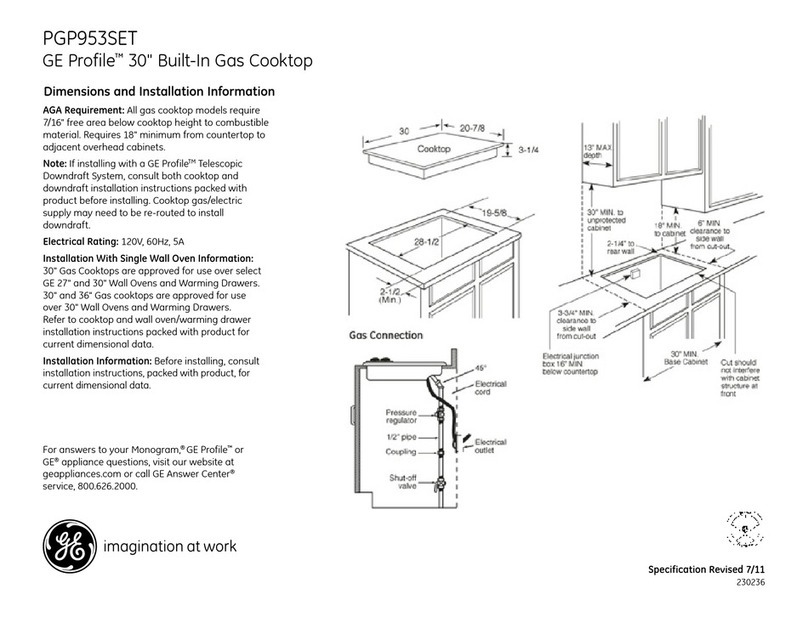
GE
GE Profile PGP953SETSS Dimensions and installation information
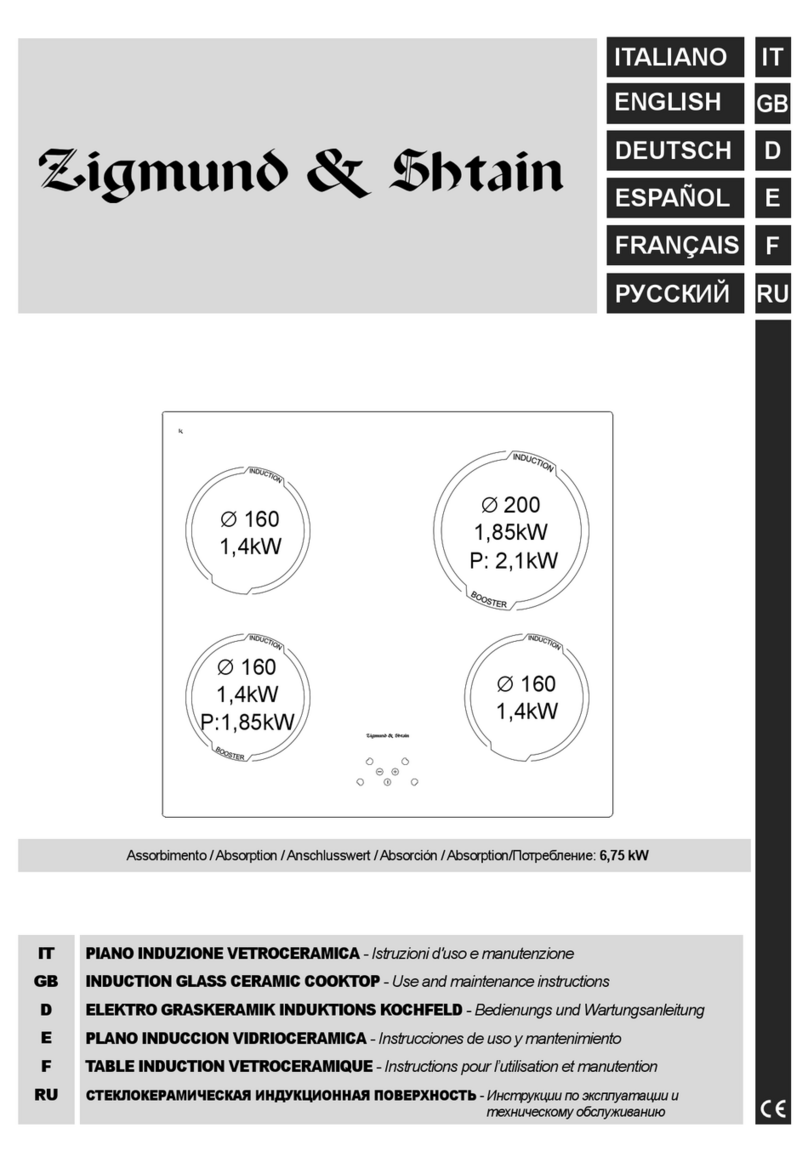
Zigmund & Shtain
Zigmund & Shtain 3PCLIOBI3640ZS Use and maintenance instructions
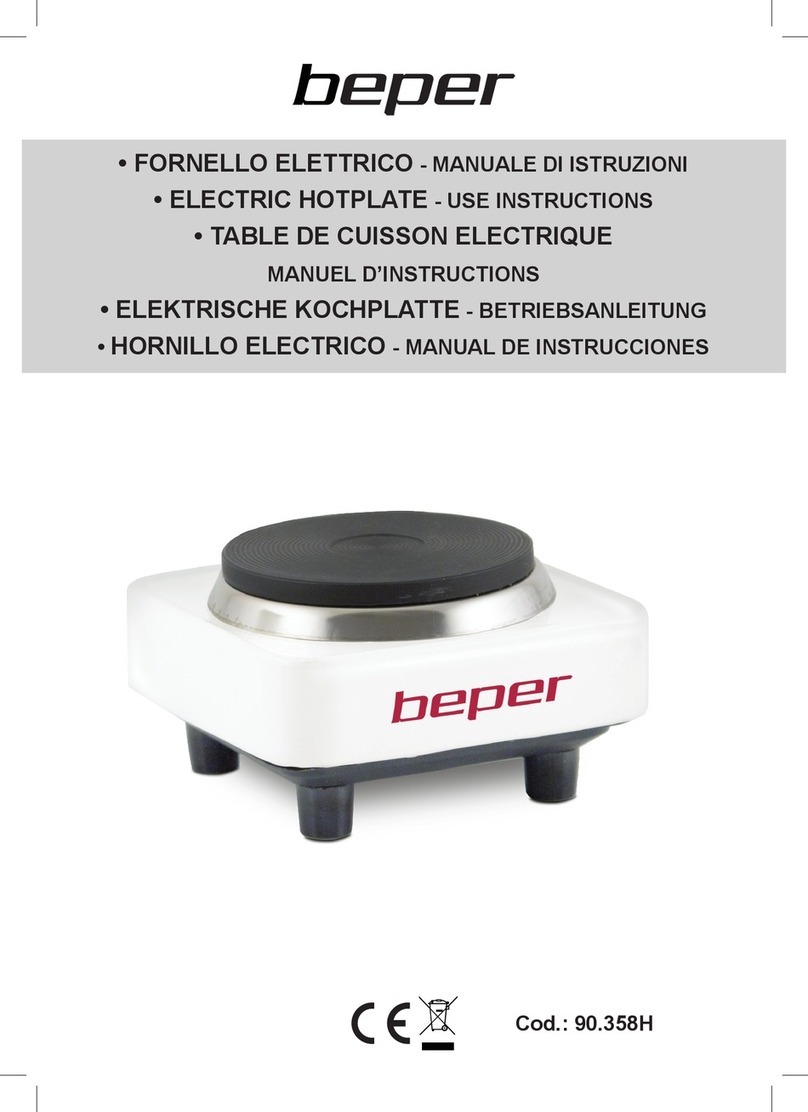
Beper
Beper 90.358H use instructions
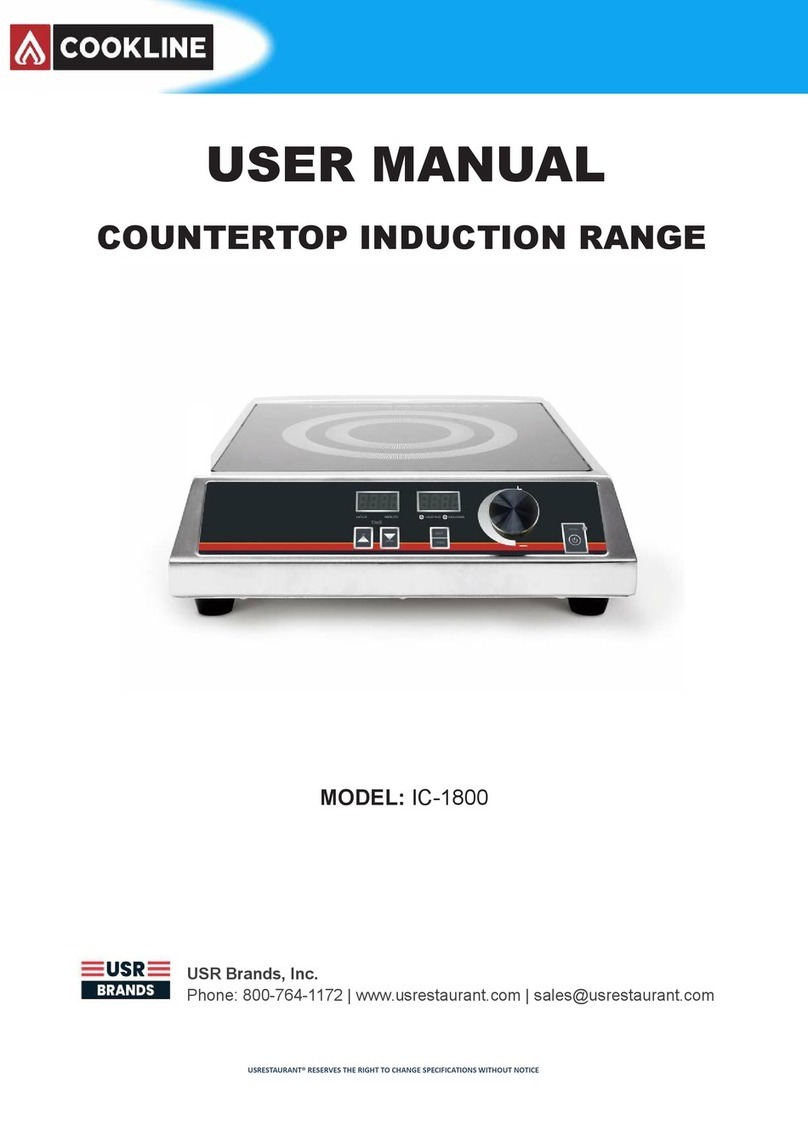
USR Brands
USR Brands Cookline IC-1800 user manual
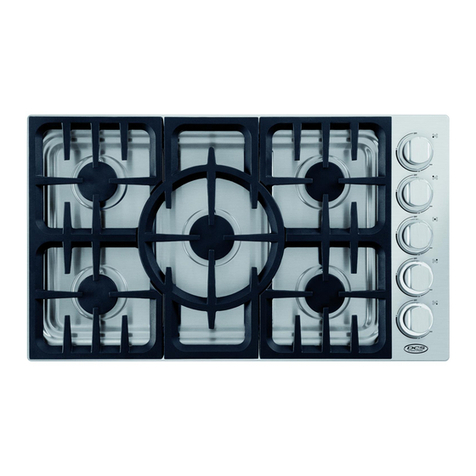
Fisher & Paykel
Fisher & Paykel DCS CDU Installation instructions and user guide


